For a long time I was ambivalent about the ELKA Synthex. Strong, powerful and brilliant on the one hand, too brilliant (perhaps), too clean and maybe even too digital on the other.
So, it’s not surprising I went through quite a few Synthex – bought them, sold them, bought them, sold them – until, several months after selling the last one, I finally realized the special value of the instrument. My own soundfiles have since convinced me that this strange analog synthesizer is in a class of its very own.
My resulting search for that last-Synthex-after-my-final-Synthex took almost half a year (since we all know that if you really need something, you won’t be able to find it right away). I found my prize there, where ELKA originally had its production factory – in Ancona, Italy.
Ah, yes … Ancona … (and thanks to Enrico Cosimi for this information):
“The Elka factory was near Ancona; Mario Maggi lives in Rome and, for the preproduction of the synth, was driving Rome – Ancona / Ancona – Rome all the time …”
Update Nov. 2012: The Elka factory was in Zona Industriale Squartabue, Villa Musone, Recanati, which, to be exact, is southwest of Ancona. Thanks to Marcello for this detailled information.
Today I’m of the opinion that the Synthex is among the Top-10 analog polyphonic synthesizers ever made, and probably among the Top-5 analog poly-synths of all time. That sort of analog/digital sound I hated (and loved) for many years is marvellous to my ears today. (Interesting: sensitivity and taste of hearing can change radically within a couple of years.)
To be honest, you might be happier with a Roland Jupiter-8, Oberheim OB-X, Sequential Prophet-5 or Memorymoog, if you’re looking for an aggressive, vibrant analog poly-synth. Still, that specifically clear, powerful and warm sound the Synthex emanates is unique, in a class of its own.
ELKA … who ..?
As everyone knows, ELKA never produced professional synthesizers until the Synthex. It was way back in the early 80s when the company recognized that they needed some flexibility in their production line. Organs, Hammond-substitutes and cheap electric pianos – their staples for many years – had gone out of fashion. Like CRUMAR (a few years later), ELKA established, in a bid for survival, a new production of synthesizers.
This scheme didn’t really work out, and they had to close in 1988. However, thanks to that marketing plan of the early 80s, the Synthex was on production. What luck!
Their 8-voice 16-DCO synthesizer was originally developed by Mario Maggi. That modest and skilled technician from Rome oversaw the production of many excellent instruments: the CRUMAR Bit One, the Bit 99 and … the ELKA Synthex.
Maggi had been developing and building one-of-a-kind synthesizers since the early 1970s: a quasi-Italian ARP 2600, or the Memory Controlled Synthesizer MCS-70, a massive monophonic synth with memories. The latter instrument, restored in 2020 (see this Youtube video), can be heard on the recommended LP „Automat“ from 1978. In that year, the glorious Sequential Prophet-5 came on the market and Maggi was immediately inspired to create his own poly-synthesizer.
Maggi completed the prototype of his 8-voice polyphonic analog synth after 3 years of development – in 1981. But his project did not arouse any interest among Italian synthesizer manufacturers. Rejections from all sides. More or less by chance (joining a friend who was taking a broken instrument to service), he made one last attempt and showed the project to the organ manufacturer ELKA. That historical meeting took place under a good omen: One had what the other was looking for.
After a final revision, Maggi’s polyphonic synthesizer appeared as SYNTHEX at the Frankfurt Musikmesse in 1982. Exemplary of the positive responses, the British guitarist, keyboardist and sound designer Paul Wiffen praised the 8-voice Synthex for its then modern and particularly advanced features: stable oscillators, multi-mode filter, 4-track sequencer and on-board chorus.
How the Synthex came to its excellent factory presets
Paul Wiffen – founder, together with Chris Huggett, of the Oxford Synthesizer Company at the end of 1981, and co-designer of the OSCar – was asked by ELKA to create the Synthex factory presets. Those excellent pre-fabricated sounds – programmed in 1982! – would later write synth-pop history, especially after the recordings of Jean-Michel Jarre.
„I needed to go earn some money, so became Elka’s Synthex demonstrator at the [ … ] Frankfurt [ … ]. Elka followed [ … ] with an offer to do all the factory presets, which I did in my flat on the Goldhawk Road that summer.“
(Paul Wiffen in: www.electricityclub.co.uk/synth-guru-interview)
Positive responses from the Frankfurt Musikmesse encouraged ELKA to sign on Mario Maggi, who taught synthesizer skills to their in-house organ technicians – a prerequisite for the serial production of the Synthex. (Needless to say, those Italian organ technicians learned their lessons well.)
It happened as it always does: Mario Maggi was hired to oversee production and check that first batch of Synthex instruments (at the end of the contract, ELKA would tell him to leave!). Aside from some small technical upgrades (such as a basic MIDI implementation), the Synthex remained pretty much the same throughout its manufacturing history. Production, starting in 1982, ended around 1987.
[ By the way: Only a small part of Maggi’s many ideas and conceptional plans for his polyphonic synthesizer were actually materialized by ELKA. What a shame. The time schedule was tight and money was short. It remains for us to imagine what that paradigm Synthex might have been like. Maggi had a multitude of ideas and many great concepts for developing that synth …
A friend of Mario Maggi, Paolo Groppioni (GRP), reports that the engineer has again been working on a Synthex 2 since the 1990s. Regrettably, the personable (possibly too perfectionist) Maggi has not yet succeeded in bringing this follow-up project to a close. The vision of a Synthex 2 might just remain that: a vision. ]
Back to the years 1982/1983. Since ELKA had not previously been a synthesizer company, it came as no surprise that marketing the Synthex was problematic. People just won’t eat anything they’ve never seen before. ELKA … who ??? The name was the problem, not the product itself.
Then again, 1983 wasn’t a good year to sell any keyboard other than the Yamaha DX7. Be that as it may, ELKA wasn’t happy with their Synthex, highly professional or not.
Paul Wiffen:
“Unfortunately, by the time my guerilla marketing started to pay off – getting the Synthex on TV with players like Peter Oxendale in Bonnie Tyler’s ‘Total Eclipse Of The Heart’, Mark Stanway of Magnum and Phil Lynott in Grand Slam – Elka had lost faith in the instrument and were selling it off directly for £500 through the music technology magazine Electronics and Music Maker. Some people got a magnificent bargain, considering the original retail price was over three grand.
As payment for programming work on some hideous FM-based unit that Elka came out with (my mind has deliberately blanked out the model number), I got Elka-Orla to give me two of the last Synthexes and to ship one of them to Los Angeles, where I was moving. Called in to try to make sense of Stevie Wonder’s new Sequential Studio 440 drum machine (into which my Prophet 2000 samples would thankfully load), I was soon up to my old tricks, asking if I could bring in other synths. Next thing we were MIDIing the OSCar and Synthex together for the killer bass sound on his 1987 single ‚Skeletons‘ and I was in there.
After the album’s release, I toured the world with Stevie as MIDI programmer, ensconced under the stage with the Synclavier guy. Unfortunately, because of their limited MIDI implementation, neither the Synthex nor the OSCar went on the road (except recorded into the Synclavier), but Elka-Orla cobbled together one last Synthex for Stevie from several ones that had been cannibalised for parts (because I refused to sell him mine).”
(from the Sound on Sound Interview with Paul Wiffen, December 1999)
How many Synthex were actually produced?
The Synthex story in a nutshell. We have no production statistics, but have been watching the instruments on the used market for at least 15 years. Interestingly enough, there seems to be no Synthex with a serial number lower than #700. The lowest Ser. No. we’ve ever seen is #705 …
The few Synthexes with #7xx serials were 117V models and probably for shipping overseas to the US market. Instruments from #800 upwards were 220V models and bound for the European market. None of these early units were equipped with MIDI, but many of them were later retrofitted with the Computer-Interface / MIDI Break-Out-Box. Direct installation of the MIDI-Trio found its way, finally, into the last 300 units (from #1300 to #1600).
We take it for granted that main production started with Ser. No. #700 and ended somewhere around #1600. Taking early units without serial numbers into account, we assume that a total of 900 to 1000 Synthex were produced. There was one last Synthex made for Stevie Wonder just before the company closed its doors in 1988 – as Paul Wiffen explained in the interview quoted above. In short, that’s the Synthex story.
Hardware
In general, Italian synths have a poor reputation as to their technical reliability. Take any Siel, Crumar, Farfisa instrument … most of them come with poor- to medium-quality hardware. The Synthex is the one big exception! Great knobs, quality switches, solid housing, a well-thought-out, clearly structured interior and a very playable keyboard. Much better than any of those cumbersome keys on the early Oberheims, even better than those of the Jupiter-8. Synthex – a truly professional instrument.
Still, to be honest, the Synthex is – once in a blue moon – a bit unreliable. Which is no wonder – there are 1000 ICs inside. So, on this or that very rare occasion, breakdowns do occur.
But then again, spare parts are a point of consideration with all vintage synthesizers. What happens if one of those displays on your Oberheim Matrix-12 or Xpander stops functioning properly? What if any of those special chips in a Sequential Prophet VS need to be replaced? And what about the custom-ICs used in early polyphonic Yamaha CS-synths? Vintage synthesizers carry an inherent risk. A fact of life.
A singular advantage of the ELKA Synthex is that 99% of its electronic parts are standard parts, still easily available today. Actually, deficient Synthex parts are not the real problem, it’s finding out where that problem lies. Localizing the defect may take several hours, whereas replacing the broken part could be just a matter of minutes.
Interface development
– Very early models did not have that little housing for the fan found in the later Synthex. And those early models only offered the one Sequencer In / Out trigger option. There was no other interface.
– Next step: implementation of the Computer Interface. The first batch of Synthex were decorated with a blind metal plate – lettered (“Computer Interface”), but without any electronics inside. An interface dummy that many early Non-MIDI Synthex featured. That was not without reason, as the instruments could thus be retrofitted with the electronics that arrived with the MIDI Break-Out Box.
The next stage saw the actual implementation of the Computer Interface, a simple port that hooked up the extra box containing MIDI IN / OUT / THRU. From that point on, MIDI was standard. The majority of the Synthex models featured this Computer Interface + MIDI Break-Out Box solution.
– The very last 300 instruments to be produced did no longer have to be outfitted with that clumsy Computer Interface + MIDI Break-Out Box combination. Instead, the MIDI sockets were attached directly to the rear side of the instrument. Sadly, the basic functionality of the Synthex MIDI underwent no improvements. MIDI Note On/Off is – more or less – all you get.
Interface development (graphic):
The very first Synthex version (A) featured the Sequencer In / Out trigger interface only.
The next version (B) came with the Computer Interface with MIDI Break-Out Box, which went through different stages of development. Note: SEQUENCER and COMPUTER INTERFACE were sometimes written above, sometimes below the sockets.
Finally, the last version (C) had MIDI sockets directly attached to the instrument. The MIDI ports were fitted at a 45° angle to accommodate for limited space.
Features
Synthex feature summary:
- 8-voice polyphony (4-voice in split/layer mode)
- 2 DCOs per voice
- digital ring-modulation feature
- cross-modulation of PWM
- LFO 1 with extensive modulation routings
- LFO 2 controlled by joystick
- elaborate glide/portamento features
- VCF section with 4 filter modes: lowpass, bandpass 1, bandpass 2, highpass
- ADSR envelope for VCF
- ADSR envelope for VCA
- chorus section – 3 modes
- 4-track sequencer
- 40 factory presets, 40 user memories, cassette interface
- MIDI on most Synthex models
Let’s consider the following specific aspects: OSCILLATORS, FILTER, ENVELOPES and LFOs.
The Oscillators
… offer vast possibilities and they’re great to use (easy to programme).
Scaling is simply done via switches. Further, each OSC can be transposed in semi-tones within one octave (via a rotary knob).
Waveforms are selected via switches, too. Two special features: pulse-width cross-modulation and digital ring-modulation.
The Filter
… is a Synthex jewel. This CEM 3320 multimode (!) filter surpasses any of those of the other classic analog poly-synthesizers, such as Sequential Prophet-5 (Rev. 3), Roland Jupiter-8, Memorymoog, Oberheim OB-X / OB-Xa or OB-8.
Multimode tells us there are different types of filters, as on the Roland Jupiter-6. On the Synthex, there are lowpass, two types of bandpass and highpass filtering. Bandpass and highpass are the unique ones. They don’t falter, even at higher filter resonance settings, and deliver smooth and dramatically strong sounds.
The Envelopes
… are not quite up to those of a Prophet-5, Jupiter-6/8 or OB-X. They’re a bit slow (Prophet- and Jupiter-envelopes are superior here, no doubt). But those musicians who appreciate the soft and brilliant Synthex sound will learn to accept this small detriment. Besides, the envelope’s behaviour somehow fits to the instrument’s overall – clean? – slightly digital? – sound character.
The LFOs
… to be exact, there are two LFOs – are quite flexible, really. That’s one reason why a Synthex is capable of stunning FX-tones and very interesting sweep-sounds. LFO 1 offers different waveforms, as on the Prophet-5 and the Jupiter-8. Modulation routings lead either to OSC 1, OSC 2, PW 1, PW 2, FILTER, or to the AMPLIFIER.
LFO 2 offers sine-wave only and is put into play via the joystick. Routings go to the FILTER and/or to both OSCILLATORS. In Double / Split mode, a switch lets you determine whether joystick movements affect the UPPER / the LOWER sound only, or BOTH sounds at the same time.
Using the joystick as a pitch-bender for UPPER or LOWER sound only allows you to directly control minor or major frequency differences between the two sounds (from slow beatings up to a fifth).
Sequencer – a great musical tool
Not many sequencers are as flexible and user-friendly as the Synthex sequencer. Its simplicity belies its many options. In my opinion, it fosters musical expression beyond the scope of any modern, computer-based sequencer. The creation of complex grooves and poly-rhythmic patterns can be done on the Synthex in seconds.
Ok, ok, there is MIDI, of course, so – theoretically – you don’t need the internal sequencer at all. Nevertheless, that Synthex analog groove (not accessible via MIDI) is unique.
Don’t even think the sequencer is a primitive substitute for MIDI. Once you have learned how to program it, it offers a lot of surprises and is capable of some useful tricks. The Synthex sequencer is a goldmine for instant patterns à la Berlin School, for over-the-top arpeggios and much more …
That sequencer has four tracks, each with 128 steps. The later Synthex models feature multimode playback: two sounds can be independently assigned to any of the four tracks. Occasionally, earlier Synthex models had this feature as well … (honestly, we’re not yet quite clear about this point.)
Sequencer key features:
- 4 independent tracks (128 steps each).
- Multimode: two different sounds can be assigned to any of the four tracks.
- Step-by-step recording mode.
- Realtime recording mode.
- Recording of staccato– and legato notes.
- Independent step-length on each track (!) …
- Live transposing of all tracks over the total keyboard range (or split at any point, as you wish: use the bottom two octaves to transpose arpeggios in realtime, while playing your live solo in the upper section).
- The sounds themselves can be transposed within a wide range BEFORE starting to play the sequencer. That’s extremely useful. You don’t have to edit each sound independently (change scaling), you simply press “key set” in the seqencer section and hold down any key you like … the sound is immediately shifted down or up, as you wish.
- There are basic sequencer editing functions, such as Delete, Loop, Reset, of course.
- Triggering the sequencer by an external device is great! Especially when using a rhythmically complex trigger signal. Now, imagine what happens when your four Synthex-tracks – of independent length – are triggered by an external source of another (and again different) length. There is no way you can produce boring music with features like this.
- Sequencer data is transmitted to other instruments via MIDI OUT. A great feature I wasn’t aware of for a long, long time. Use the Synthex to control your Xpander, PPG Wave 2.3, OSCar, Opera-6, JD-800, Summit, or whatever MIDI-synth is currently at your fingertips.
- There’s a general GATE control for the sequenced sound.
Stereo-Out for impressive sound depth
A friend of mine got his first Synthex some months ago. When I visited him, he demonstrated this new pride of his collection, and, well, I wondered why the synthesizer sounded OK, but not nearly as spectacular as I would have expected – until I figured out that the Synthex stereo function wasn’t activated. “You don’t know what the Synthex really sounds like” I told him. We flipped the mono/stereo switch and voilà – there it was, the massive ingeniousness of the Synthex.
Be assured: playing the Synthex in DOUBLE mode can be a revelation, especially when using the same sound twice for UPPER and LOWER. You end up with a four-voice synth (with four DCOs each) – one sound to the left, one to the right. Just as stereo works.
But that’s not the end of the story. In stereo-mode, the Synthex automatically detunes both parts. Just slightly, but enough for subtle beatings between the two channels. Which results in an unbelievably large, fat sound. No Jupiter-8 (despite its stereo outputs) gives you this wide sonical scope. No other polyphonic analog synth can top the Synthex in terms of wide stereo-panorama-sounds.
Speaking of stereo-sounds, we must remark that in this aspect the classic Oberheim synthesizers (OB-X/Xa/8, Matrix12/Xpander) are impressive in their own, with their indvidual panorama positioning of each voice … but that Synthex DOUBLE sound with two de-tuned voice-paths comes straight from another planet.
In combination with its massive on-board chorus, the Synthex is capable of producing magic vintage strings. And, well, if both sounds differ only slighty in OSC tuning, LFO speed (filter frequency modulation) and other details, the stereo-image seems to expand out, out and beyond. Excellent.
By the way: if stereo, activated via that small switch, is used in NORMAL mode (one sound only), the sound appears randomly left and right. Let’s call it Ping-Pong Stereo. Another small, another impressive, detail of the Synthex.
Sound
Synthex owes its reputation to Jean-Michel Jarre. But as with Vangelis and the “CS problem” – many people think playing a CS-80 obligates you to sound like Vangelis -, the Synthex has to battle with expectations centering on that famous Laser-Harp sound on Jarre’s Rendez-Vous recording.
Synthex is far more than that. Great (deep!) basses, complex sequencer-eminations, wide (warm) strings, unusual FX-noises … you’ve got the lot. Textures in the beguiling style of the late 70s string machines, strong solo-sounds, thrilling effect-sounds in combination with external CV-to-VCF modulations (at high filter resonance settings), ingenuine sequencer / arpeggio sounds – this all is the musical world of Elka Synthex.
A propos sound: we really value the use of the sequencer, especially during the process of sound programming. While the instrument grooves, it simultaneously generates newness and individuality. The Synthex is not only a professional tool for in-depth programming. Check it out as an instrument for instant performing fun as well.
Small Minuses amid the many Big Plusses
There are points of criticism, if only a few. First, that loud Synthex fan. A tractor in your studio, technically a necessary evil (well, there might have been other possibilities for temperature stabilization), but acoustically, of course, a no-go. Solution: Have a quieter fan installed. Second, the lack of XLR audio outputs. See Jupiter-8, see Memorymoog – both offer unbalanced and balanced out(s). And third, the lack of a headphone socket. But that’s it.
Synthex today
The Elka Synthex does not have the cult status of a Roland Jupiter-8, which is reflected in its (relatively) stable secondhand market value. Located in the mid-range price area of those classic poly analog synthesizers – side by side with the Rhodes Chroma, Moog Memorymoog and Oberheim Matrix-12 – the Synthex asking price ranged from 8,000 to 12,000 Euros / USD (2019 – 2021). In 2022, prices shot up … first Synthex auctions appeared with an asking price of approx. 18,000 Euros / USD. Now, in 2023, there’s a little drop again. Current auctions vary from 9.000 to 14.000 Euros.
Black Corporation Xerxes, Cherry Audio ELKA-X …?
There is a modern, quasi rack version of the Synthex, a clone named Xerxes, now Xerxes MK2 (many thanks to Jeff for reminding us). Black Corporation has clearly modeled its instrument on the classic Elka synthesizer. Beyond that, however, we cannot draw any further comparison between the two synths.
Simple reason: a clone is a clone is a clone. No comment. Modern SMD technology, compact rack format, the lack of those important Synthex performance areas such as joystick or 4-track sequencer, the absence of the filter CV-In port … Xerxes is a clone, a good-sounding and independent instrument. The bandpass filter, for example, sounds really convincing. And then there is polyphonic aftertouch! However, it’s not a Synthex.
“XERXES delivers an unmatchable level of warmth through its two digitally controlled analog oscillators. A multimode analog filter, noise generator, 2 ADSR envelopes, 2 sync-able LFOs, unique analog BBD chorus with 3 modes, full MPE-based polyphonic aftertouch, and complete MIDI control work together to bring a classic analog sound ready to integrate into modern times.
XERXES features a beautiful, fully-analogue BBD-based chorus with 3 selectable modes, similar to the chorus effect found on the vintage Elka Synthex synthesizer. XERXES is equipped with stereo 1/4” outputs to take full advantage of the stereo chorusing effect.”
Two Youtube-Videos demonstrating the Black Corporation Xerxes:
Perfect Circuit
Mr. Firechild
Then there’s ELKA-X, software synthex developed by CHERRY AUDIO:
Elka-X replicates the extraordinary character of the original synth without compromising sound or functionality, thoughtfully expanding its feature set and delivering the authentic Synthex experience at a price anyone can afford. (cherryaudio.com)
As expected, the software Synthex looks nice. Sound-wise, however, we did not discover a single second of audio material that reminded us of the ELKA SYNTHEX. However, this is a personal view of point. Everyone is welcome to make up his or her own mind …
Cherry Audio
Simon Le Grec
Conclusion
The gist of our experience: The Synthex is both a tremendously useful and a uniquely musical instrument. An instrument that can not be replaced by any modern analog synthesizer.
Synthex: Noble hardware, high-quality workmanship, tonal flexibilty. And then there is that special Synthex SOUND. A strong, clean, sometimes over-the-top, straight DCO Sound. True, of course. Unbeatable wide panorama images in Double Mode, even without the internal chorus. True as well. A unique Stereo Sound, something no other synth offers. True, true, true.
Nonetheless, despite all our enthusiasm, please be aware: Whether the Synthex is the right instrument for your specific needs cannot be determined in any test report or video demonstration. Every musician has his own creative requirements. It takes time to find answers. And commitment. Try out the Synthex, feel it, listen to it, listen to it well, explore all those performance possibilities, check the intuitivity of the workflow. Only then can your priorities be recognized. Only then can your decision be made.
Some say the Sequential Prophet-5 is the ultimate analog poly-synthesizer (and that, no doubt, is sometimes true). Others say they would never sell their Roland Jupiter-8. No way.
Proud owners of a Moog Memorymoog (especially of the Lintronics upgraded LAMM) can’t imagine a better polyphonic analog synth than theirs. I, by turn, will not part with my Synthex. But it really makes no sense to pit one synth against another. They are all very individual, the best of them all have their place.
Synthex revisited: An analog Classic, a “vintage Workstation”, one of the greatest sounding polysynths of all time. In some respects, absolutely unbeatable.
My opinion, my conviction. To be sure.
x
Addendum: Many thanks to Boniforti Flavio, who made an important contribution to the list of Synthex serial numbers. Merci!
x
2011: Release of the Elka Synthex review.
Update April 2015: The Elka Synthex seemed to be staging a comeback. Finnish company Soundion Oy Ltd had bought the bankrupt estate of GeneralMusic (Elka, GEM, LEM, …) and planned to bring back the Elka Synthex.
Update July 2015: Unfortunately, the Bring-Elka-Back refunding attempt was not successful. Soundion Oy Ltd stays tuned, though … maybe a “new” Synthex project will bring Elka back to life one day.
Update 2020 / 2021: Synthex prices have stabilized during the last years. Asking price for a Synthex in average / good condition is between 7,000 and 12,000 USD / Euros nowadays. If you’re interested in buying a Synthex and can’t find one on eBay.com or Reverb.com – have a look in Italy. Synthex are occasionally offered on www.mercatinomusicale.com …
March 2021: Synthex review major revision.
July 2021: Synthex serial numbers update.March 2022: Synthex Original Factory Presets for download available (cassette data file, don’t use it as an audio file).
x
We have attached 40 minutes of Synthex audio files. Main performance feature of the demos: the internal 4-track Synthex sequencer, performed live, of course. An external high-frequency LFO provided – via VCF CV-IN – for extreme / ring modulator-like sounds (all Synthex) … and, yes, Roland’s JD-800 contributed some noble pad sounds. The last two sound files are (c) by John Parkins – definitely worth listening to (!)
Elka Synthex
Polyphonic Analog Synthesizer, 8 Voices
with Chorus, MIDI and 4-Track Sequencer
“Vintage Workstation”
Comparison / Links:
Oberheim OB-8 – LA sound with tricky software
Roland Jupiter-8 – the grand master of synth-pop
Sequential Prophet-5 – milestone and musical legend
Moog Memorymoog – TOP vintage poly-synth with 18 VCOs
Baloran The River – an elemental SOUND force
(A modern alternative to the Synthex)
Vintage Synth Explorer
Interview with Mario Maggi
(AMAZONA.de, 2015, German only)
SoundOnSound Elka Synthex [Retrozone],
Paul Wiffen, 1999
Open / Download:
Elka Synthex Original Factory Presets (cassette data, don’t use it as an audio file)
Elka Synthex User Manual (Nov 2021, with basic MIDI info)
Elka Synthex Front View I (4000 x 2500px)
Elka Synthex Front View II (4000 x 2500px)
Elka Synthex Front View III (4000 x 2500px)
Elka Synthex Rear View (4000 x 2500px)
Expressivee Touché Elka Synthex + Tauntek Midi CC (by sorvolator):


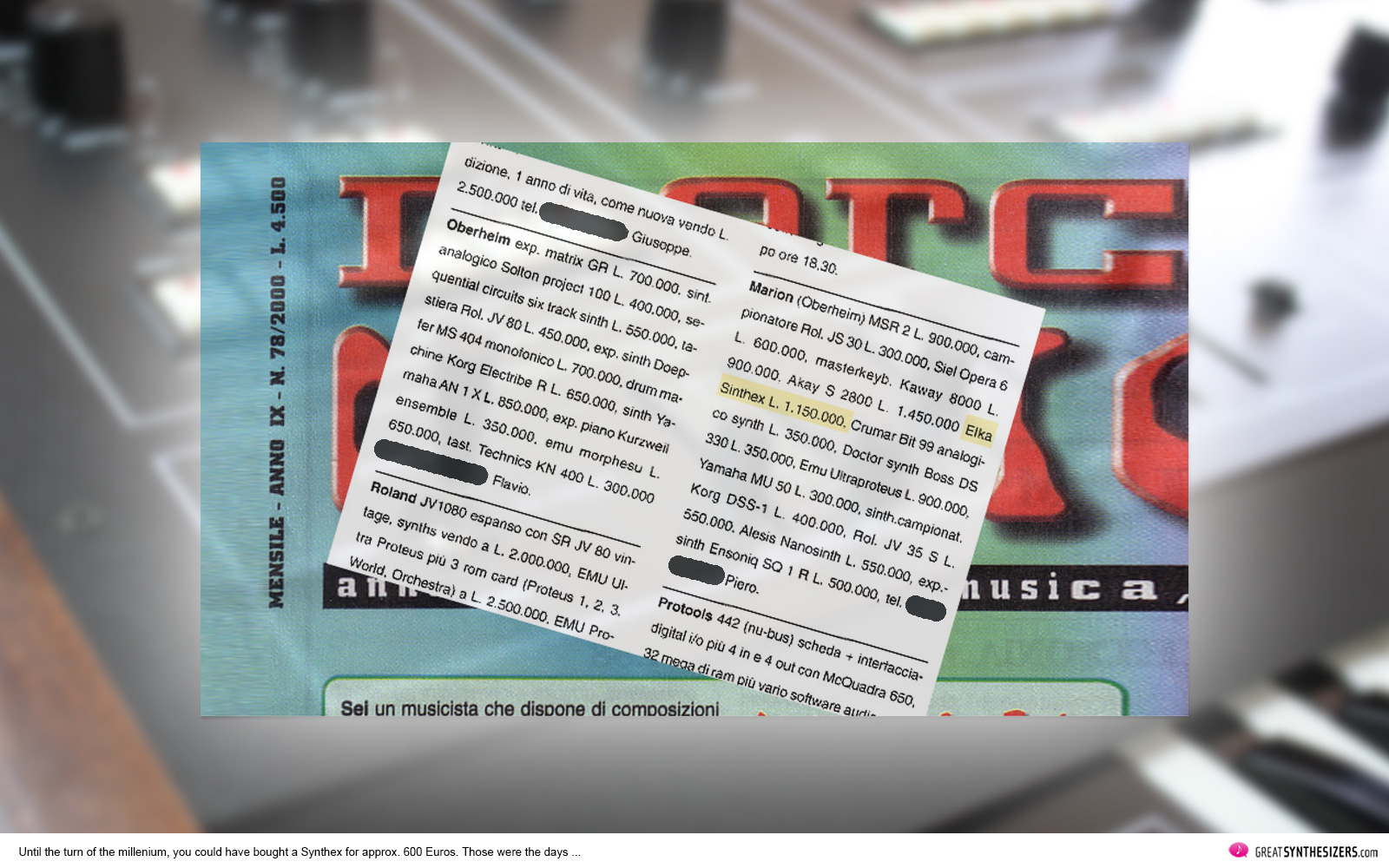


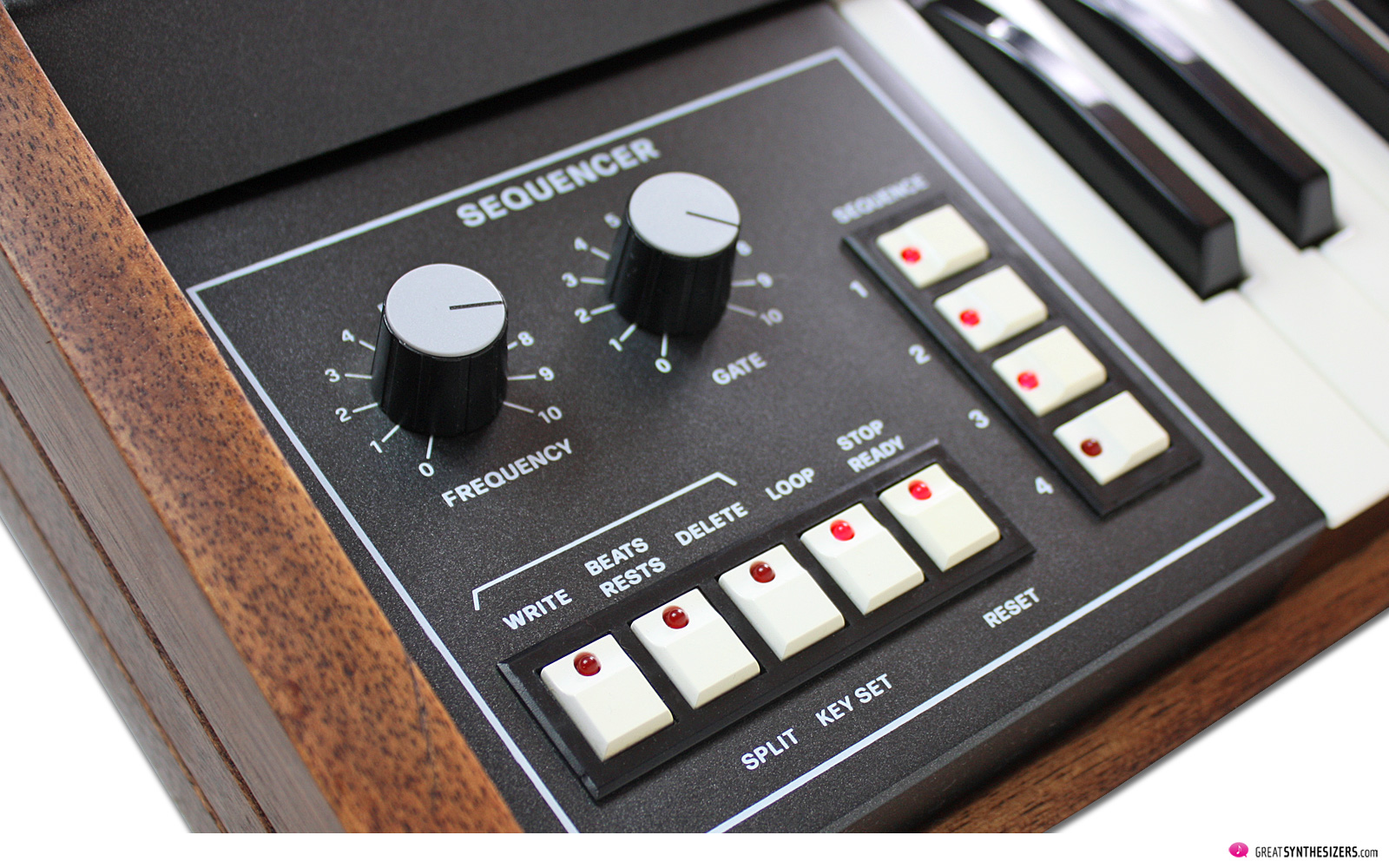


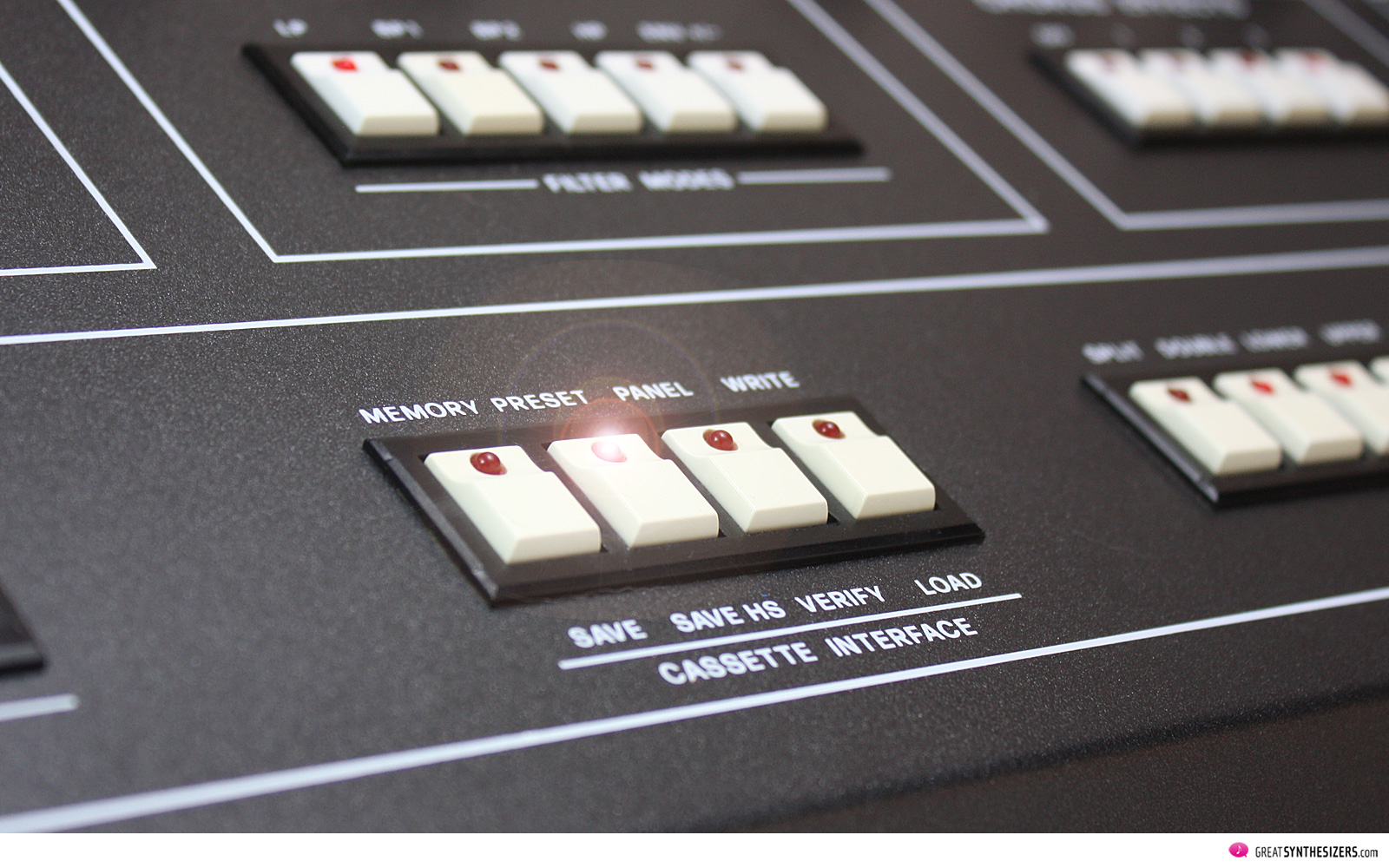

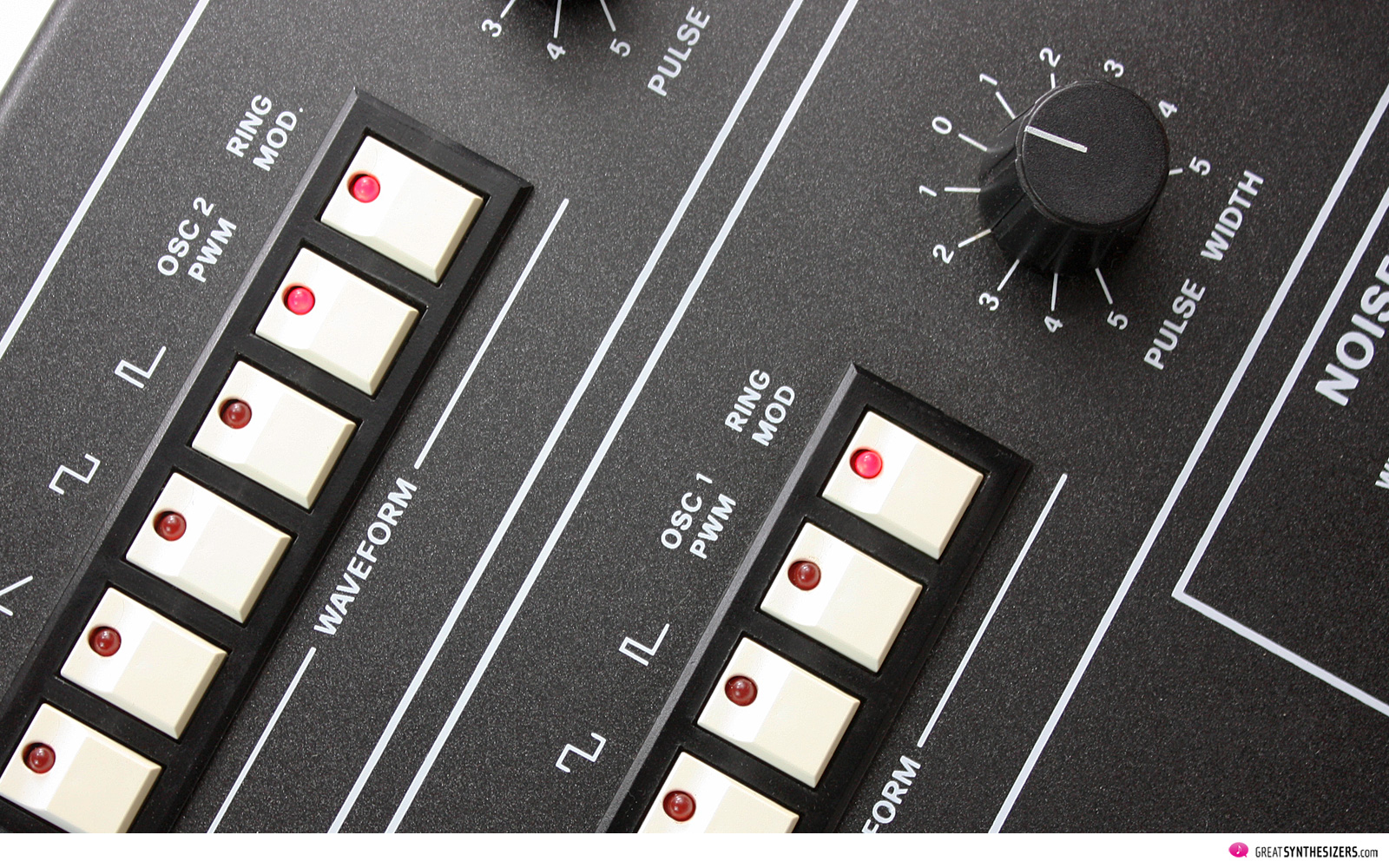

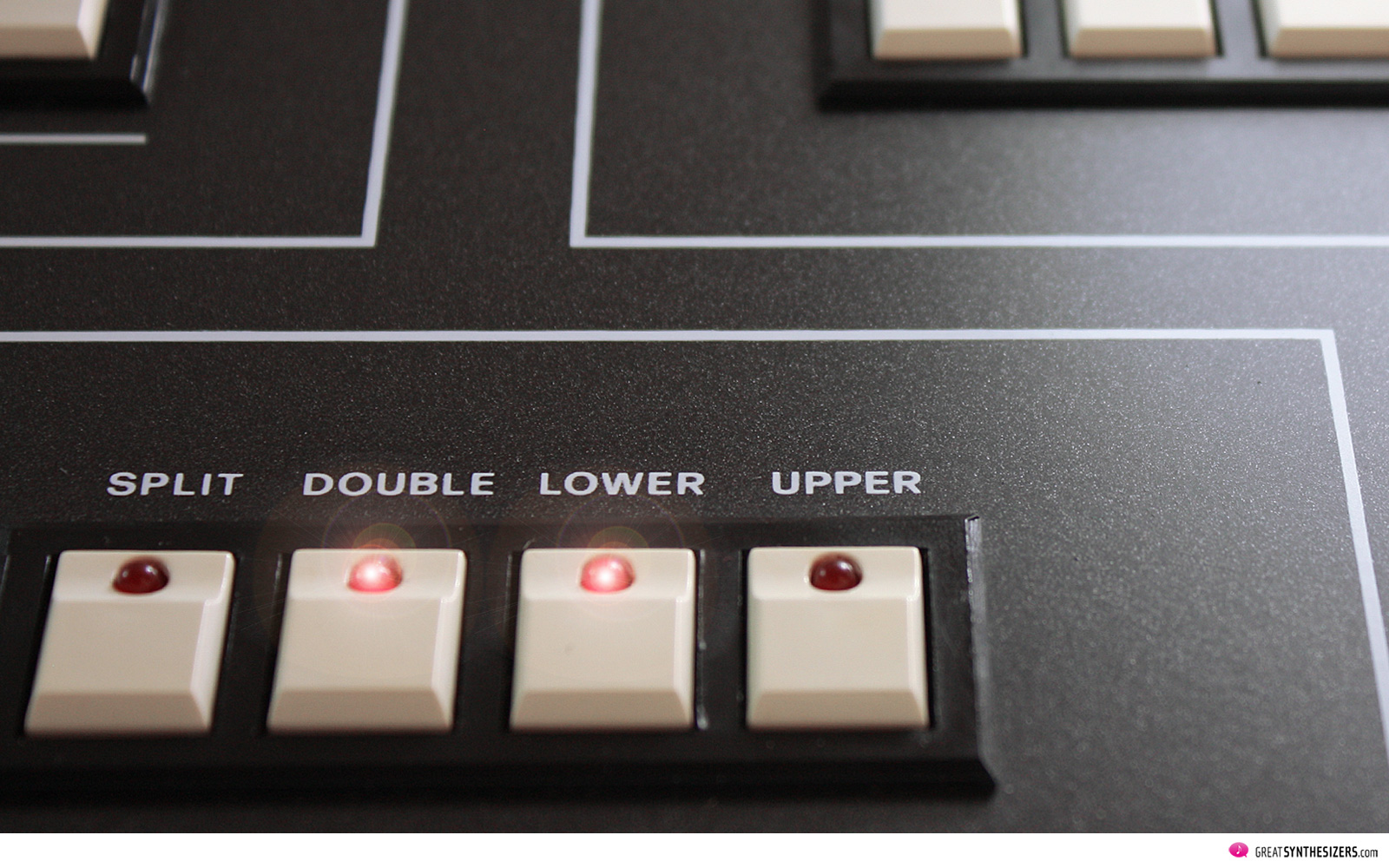
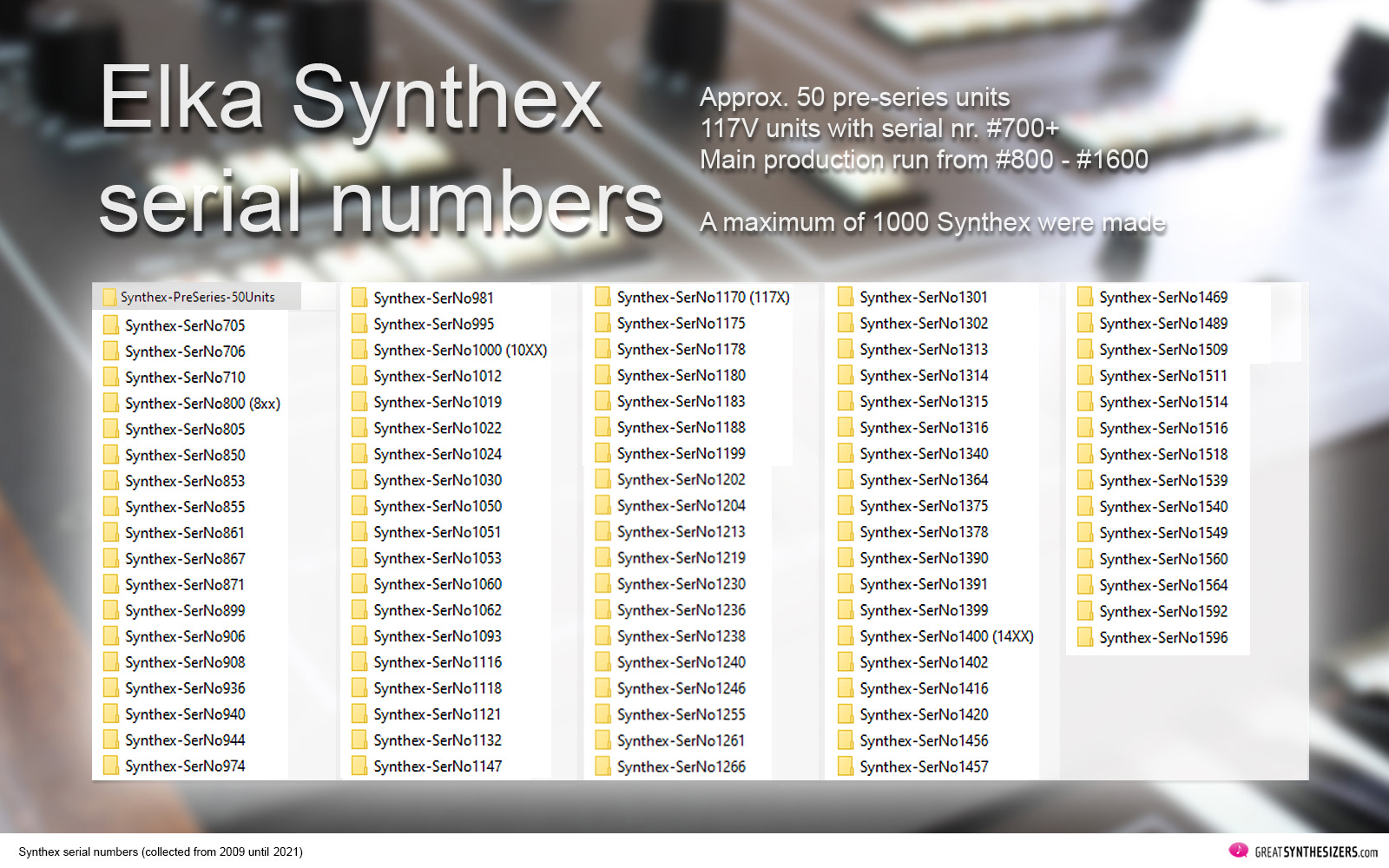
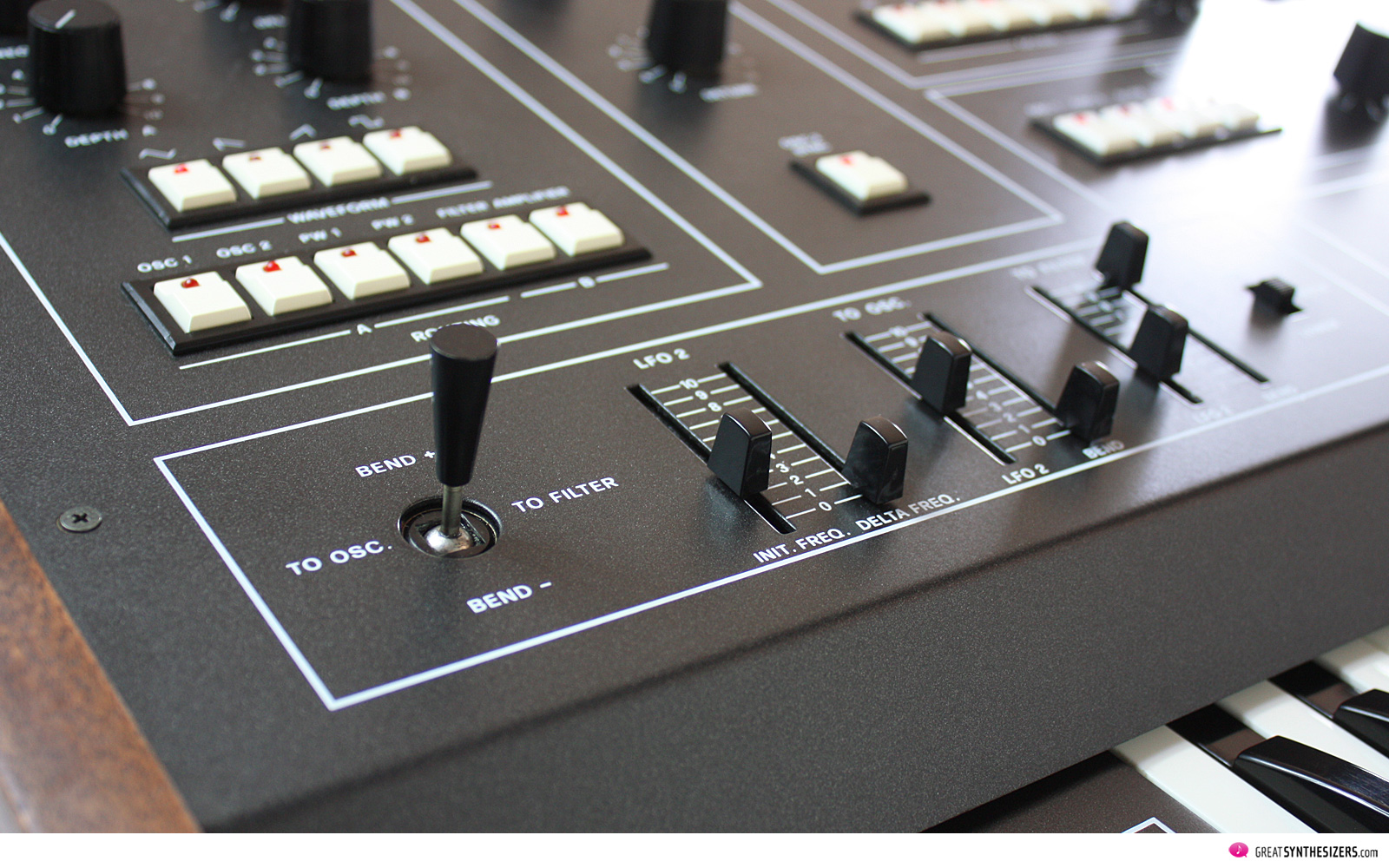
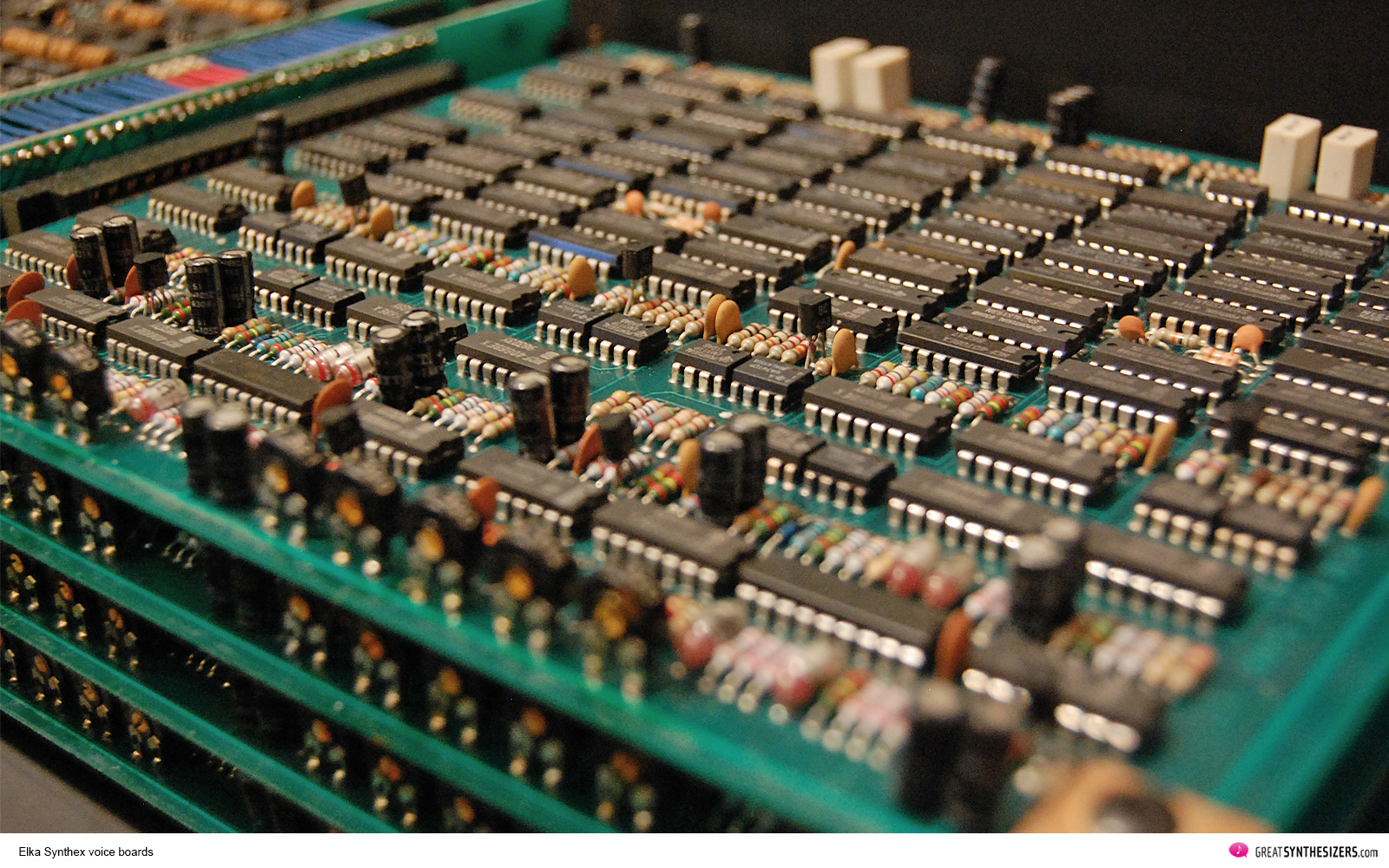

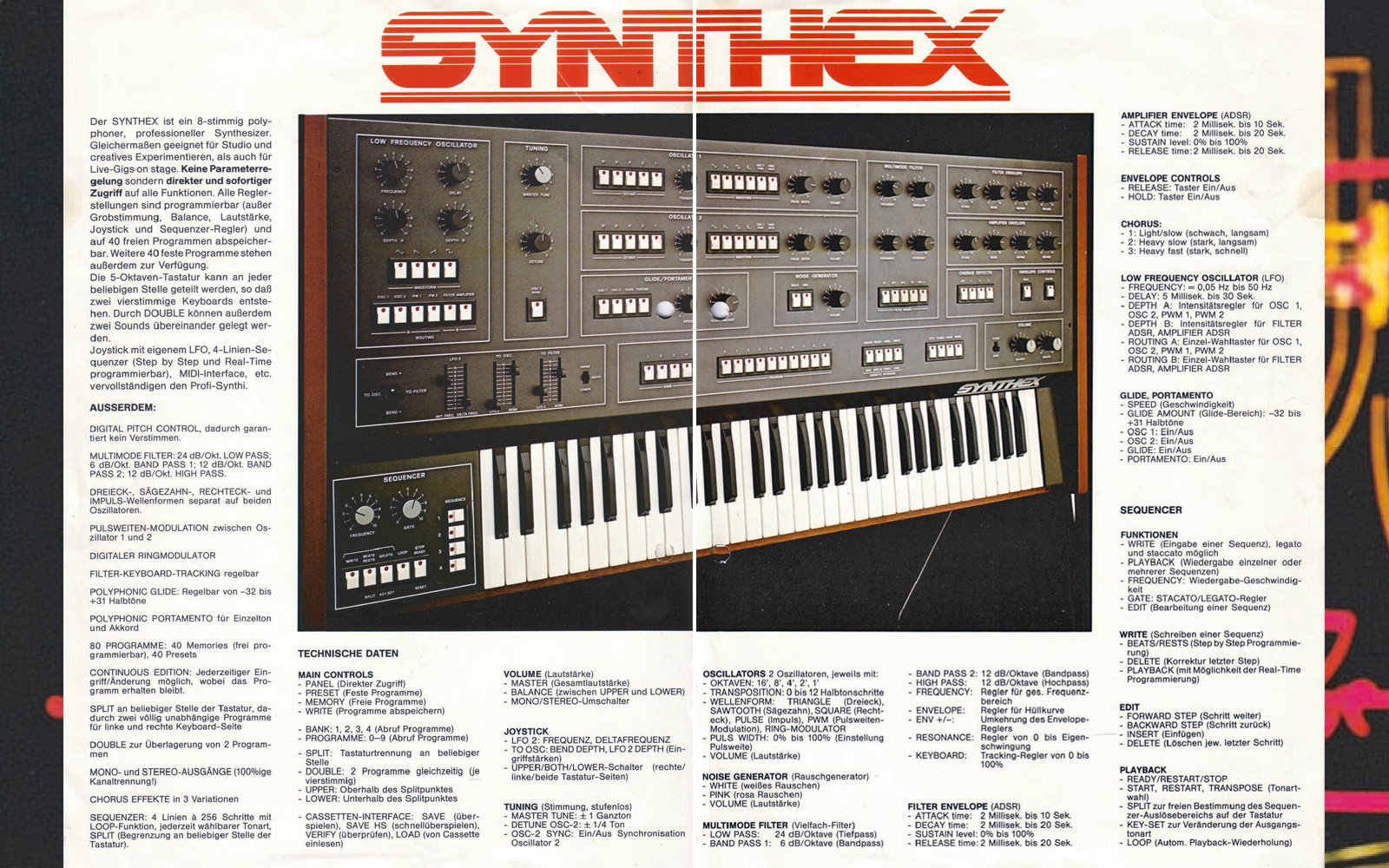

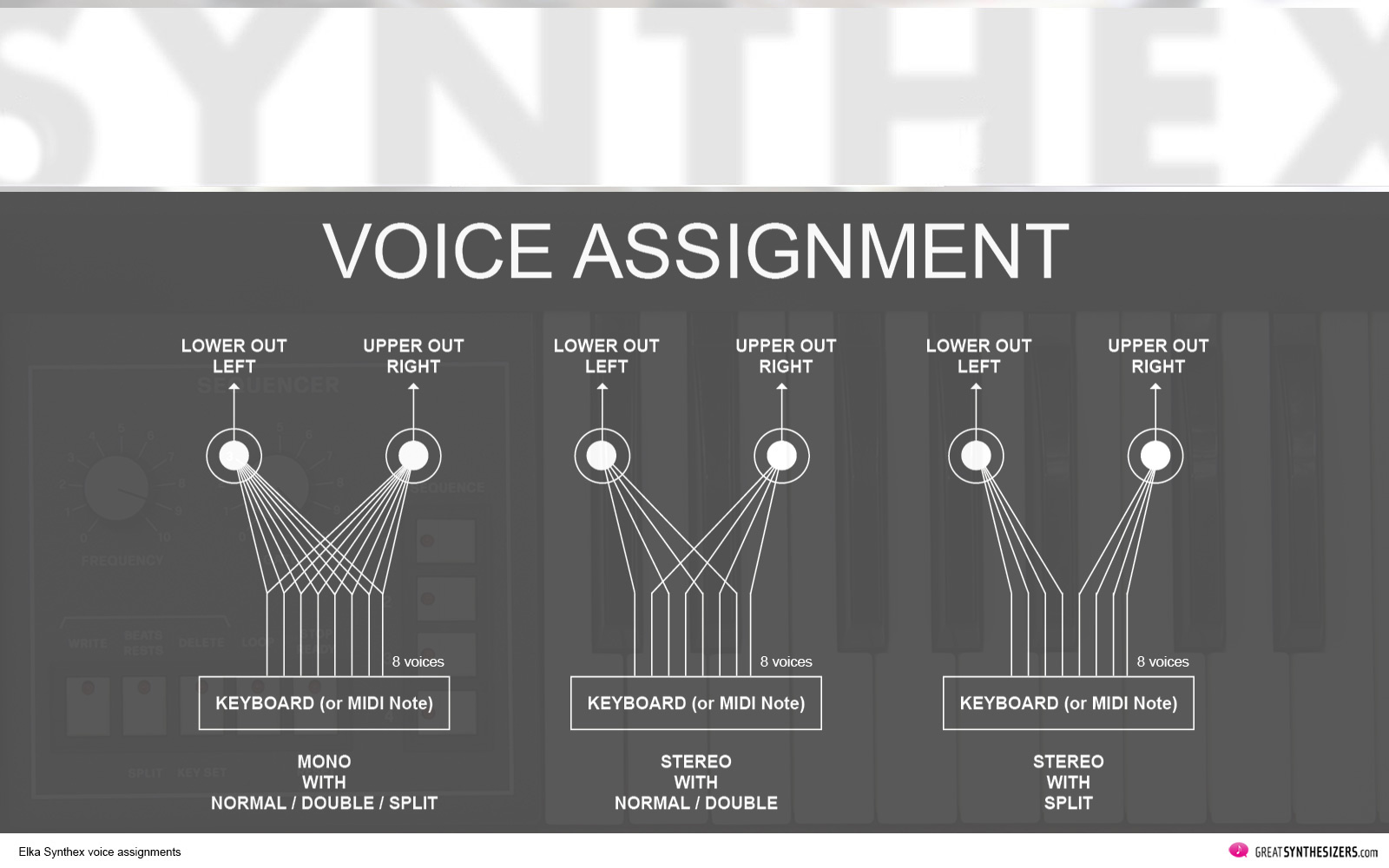
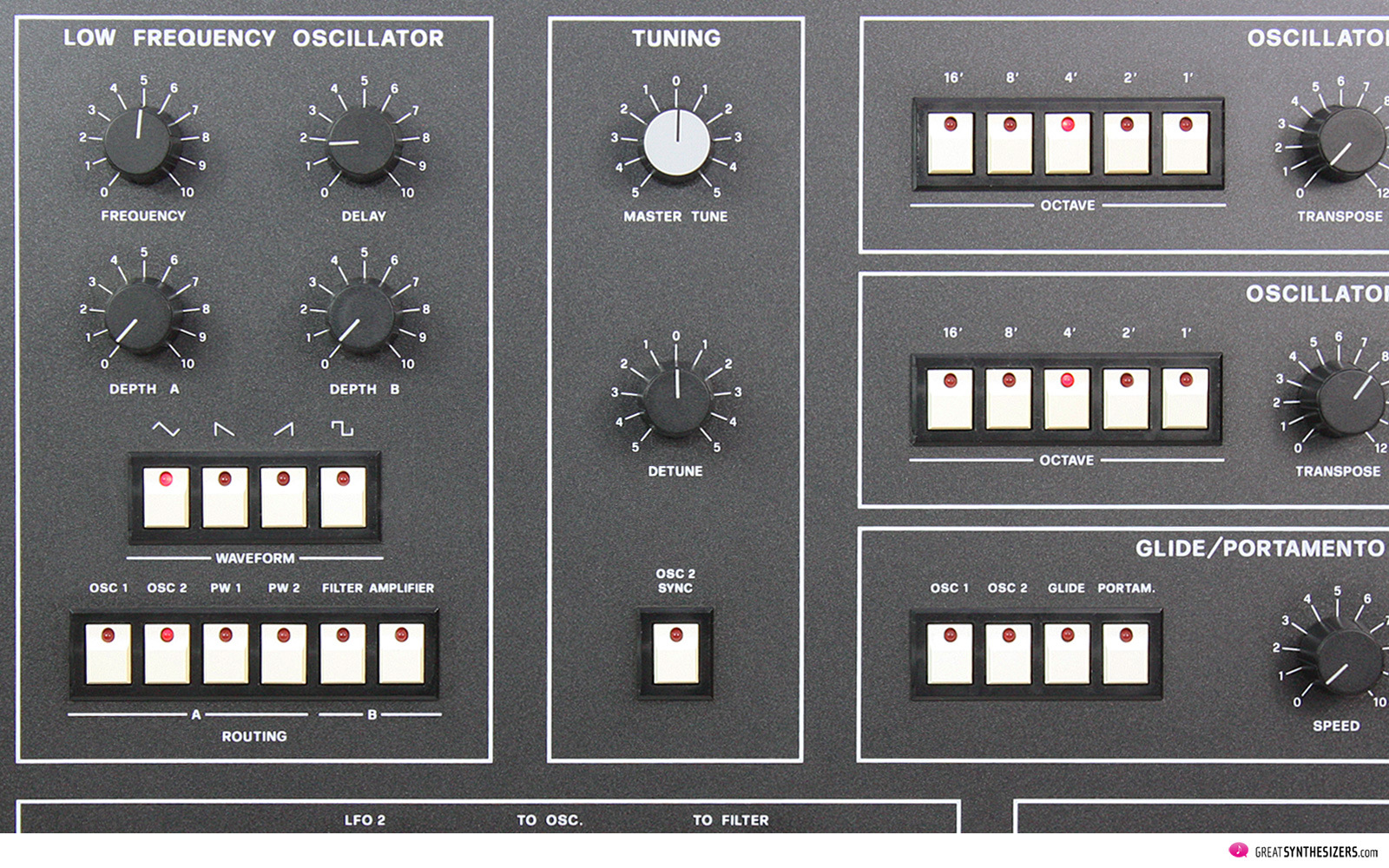

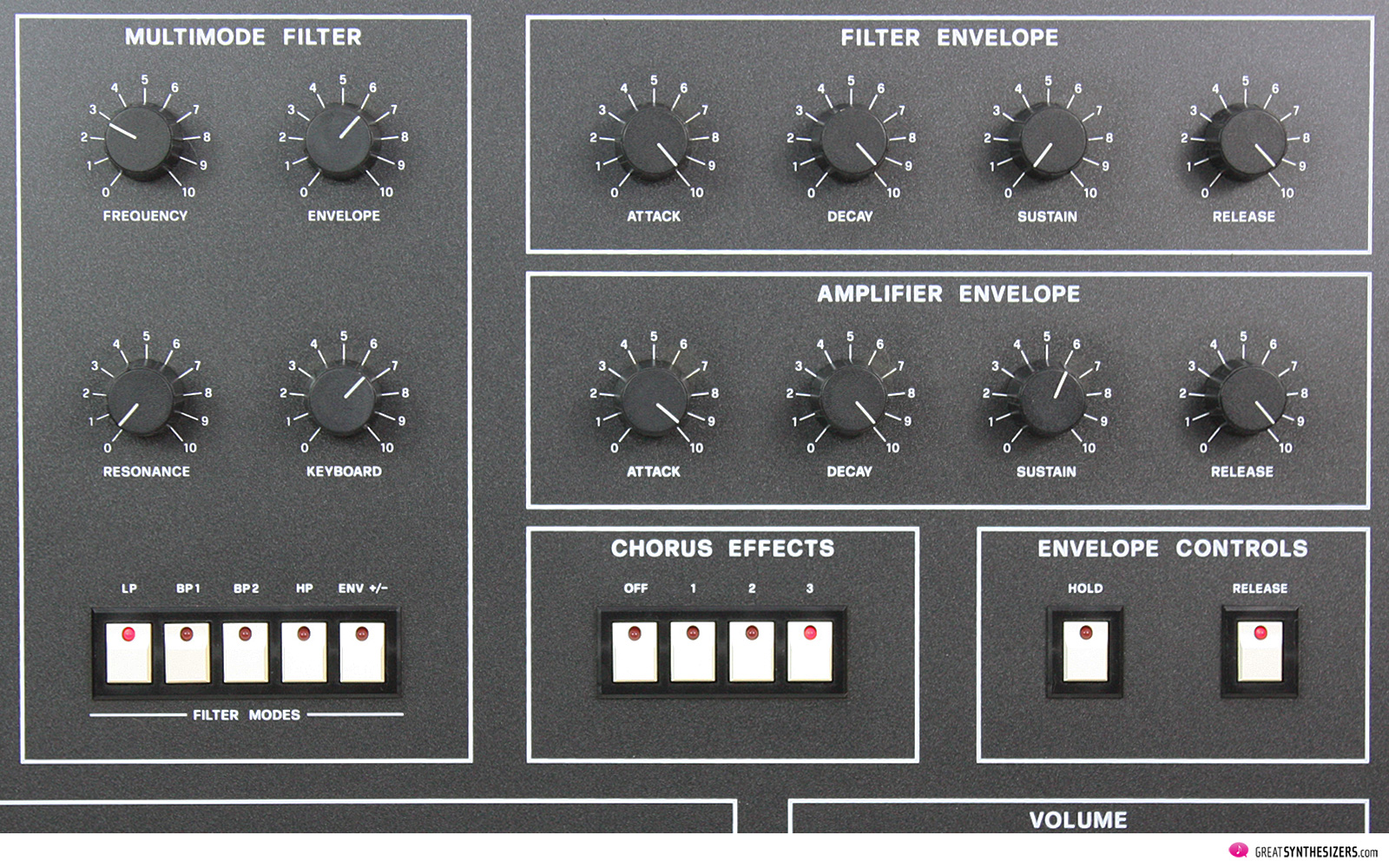
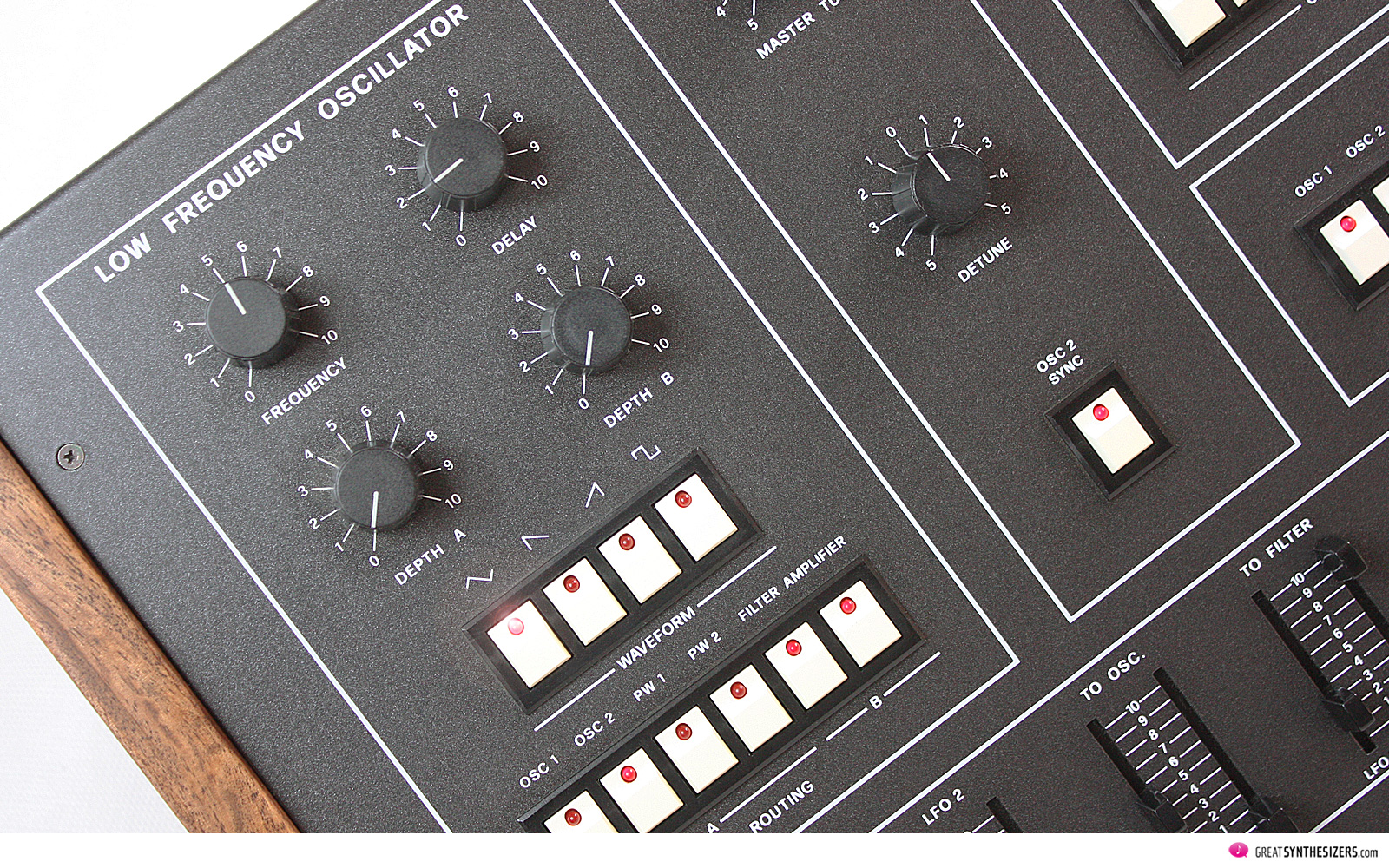
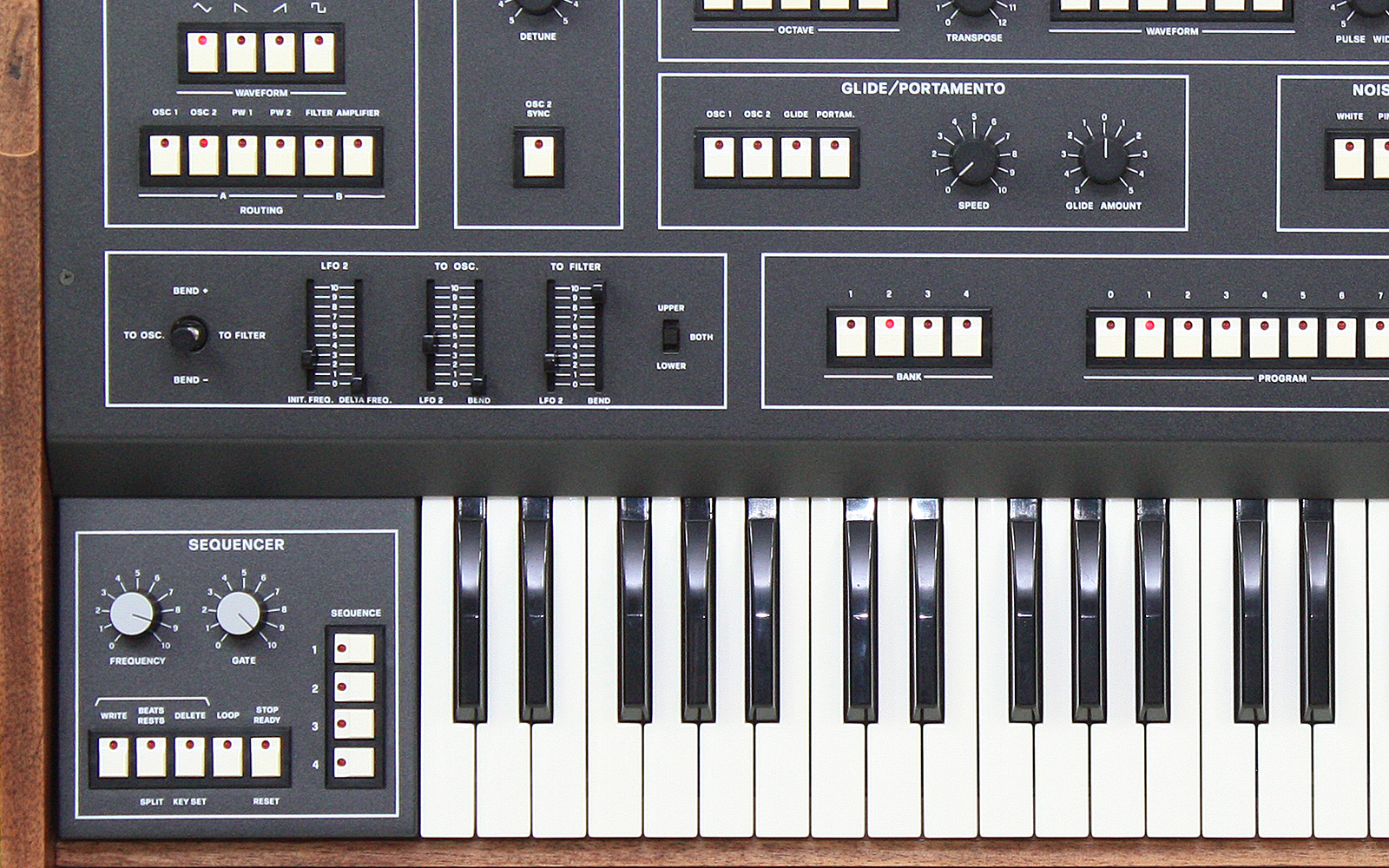

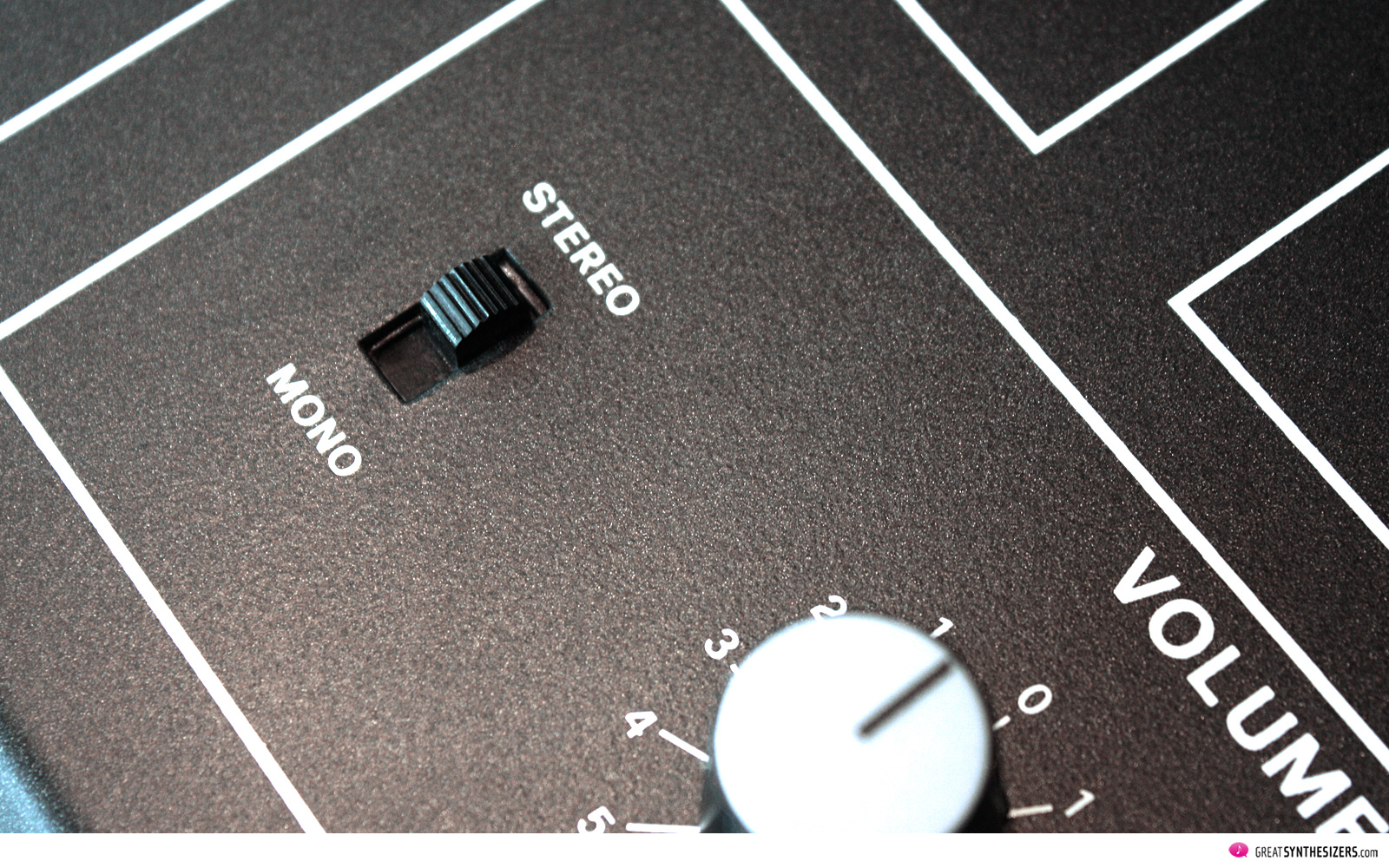

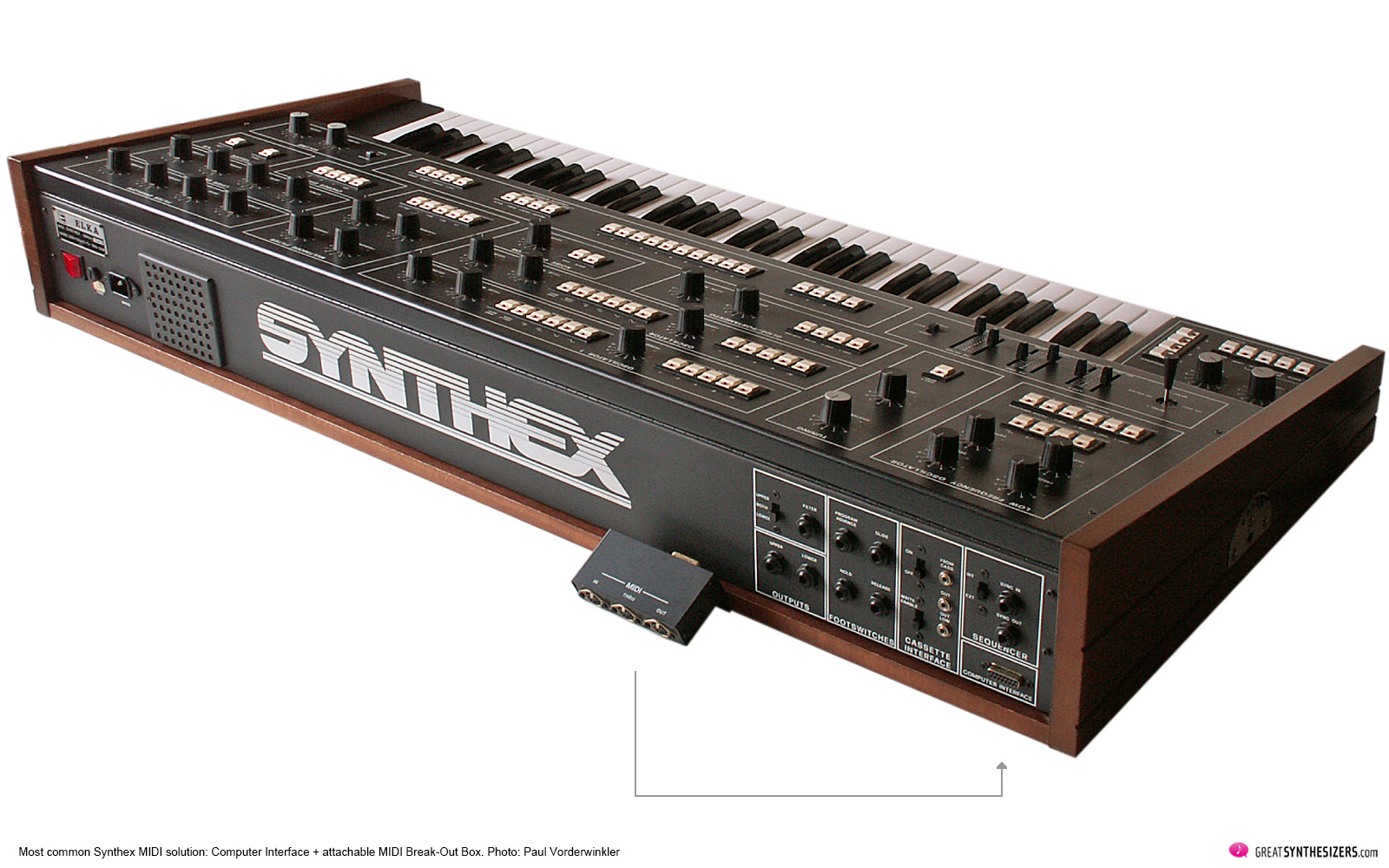
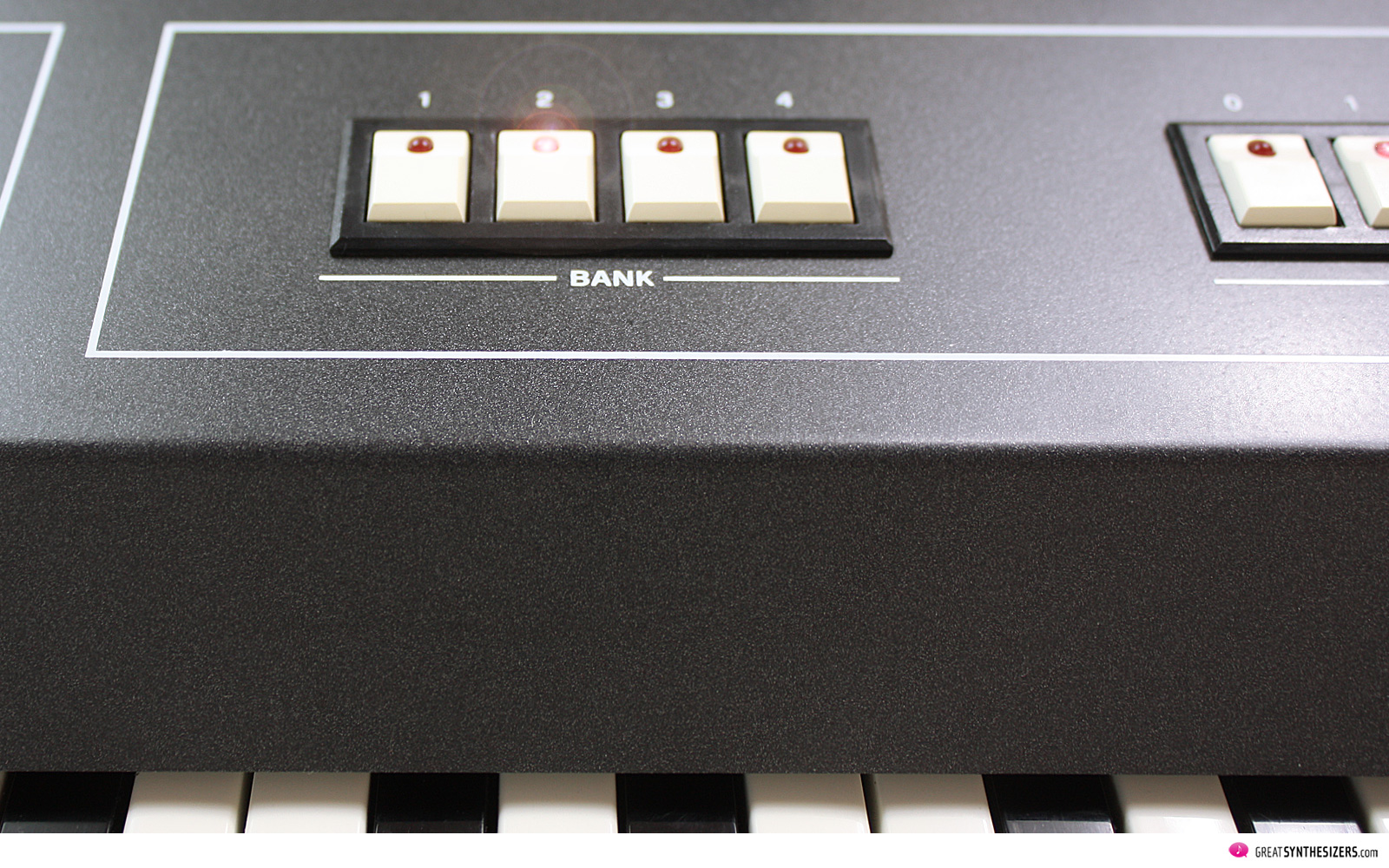
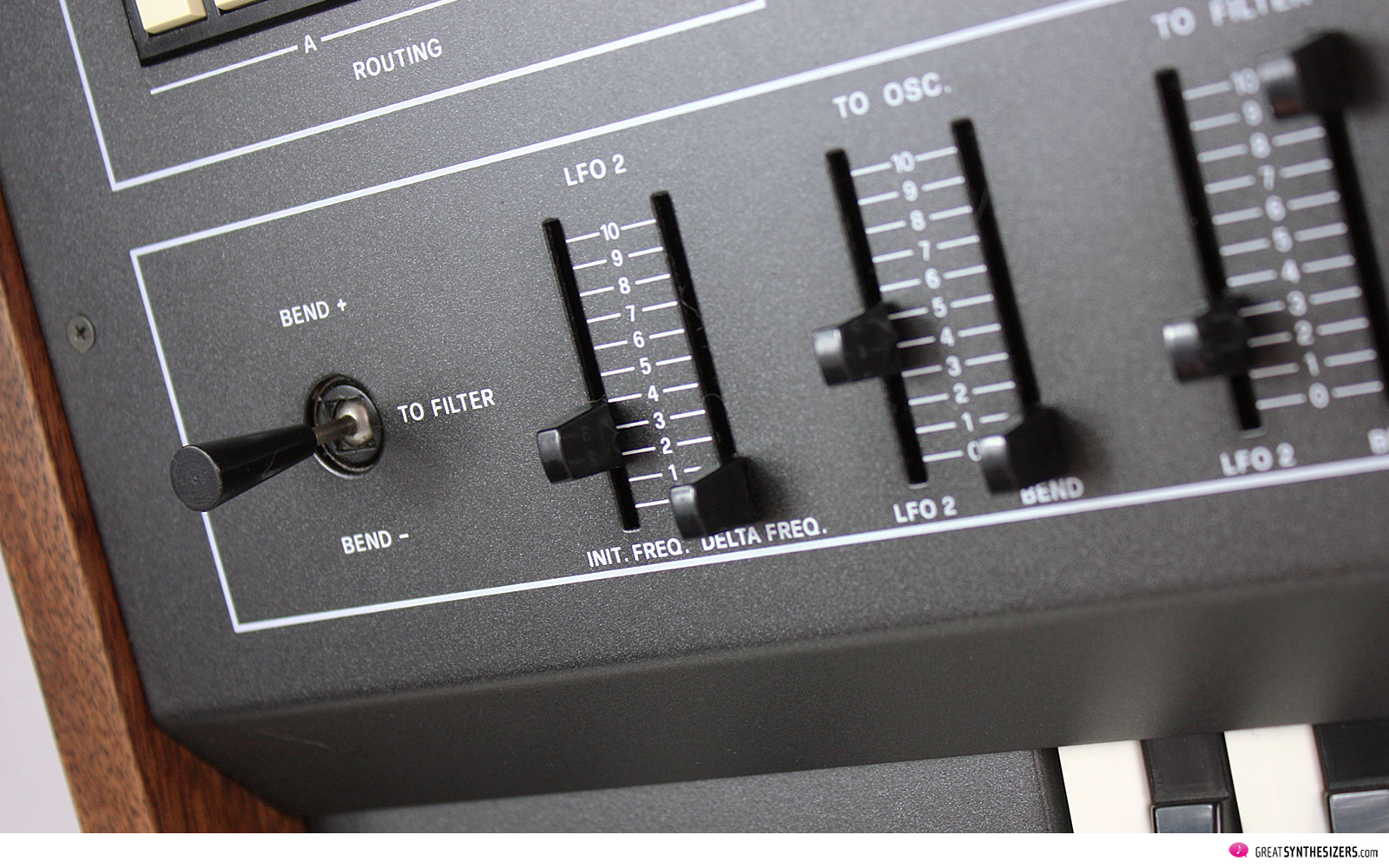
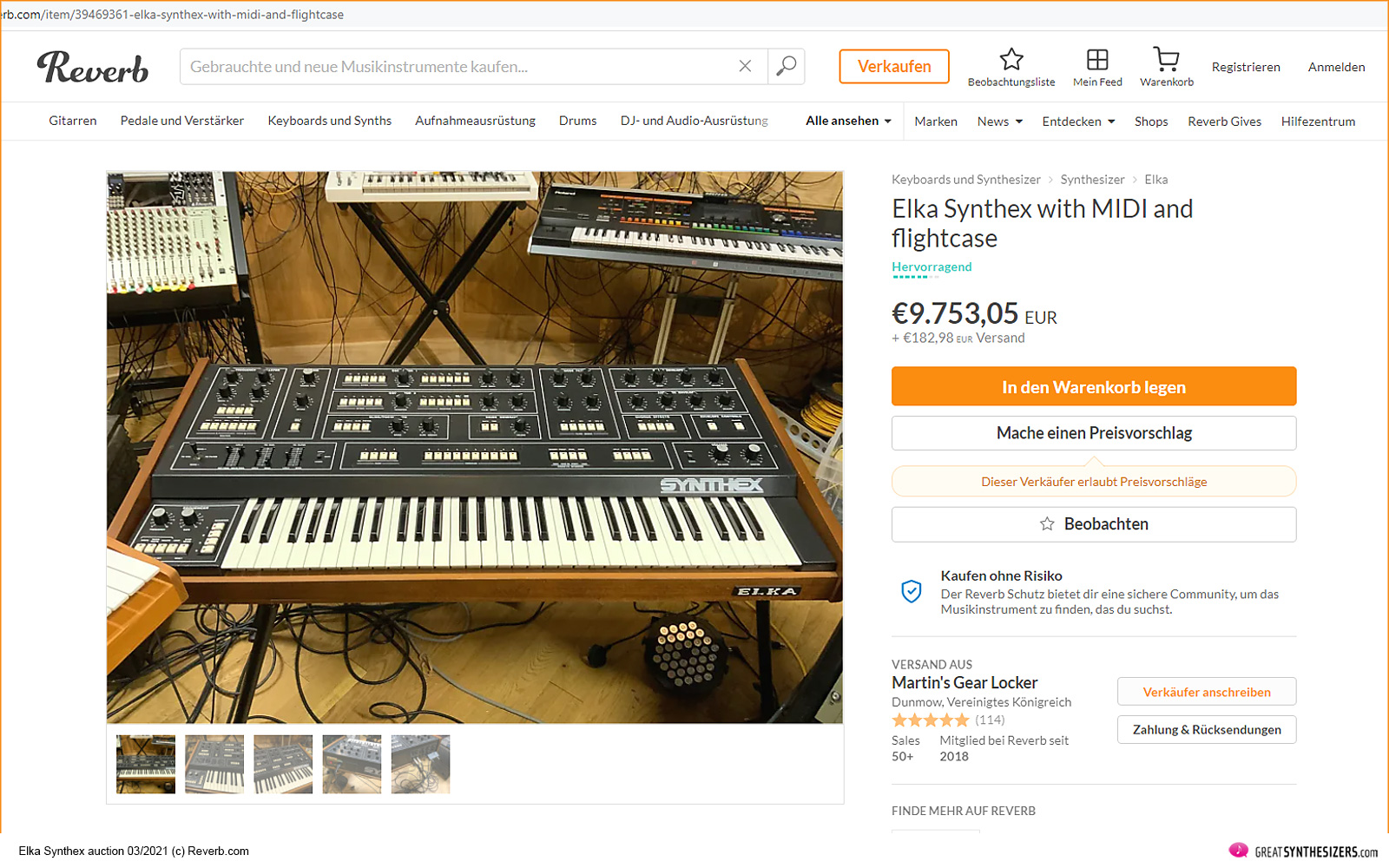
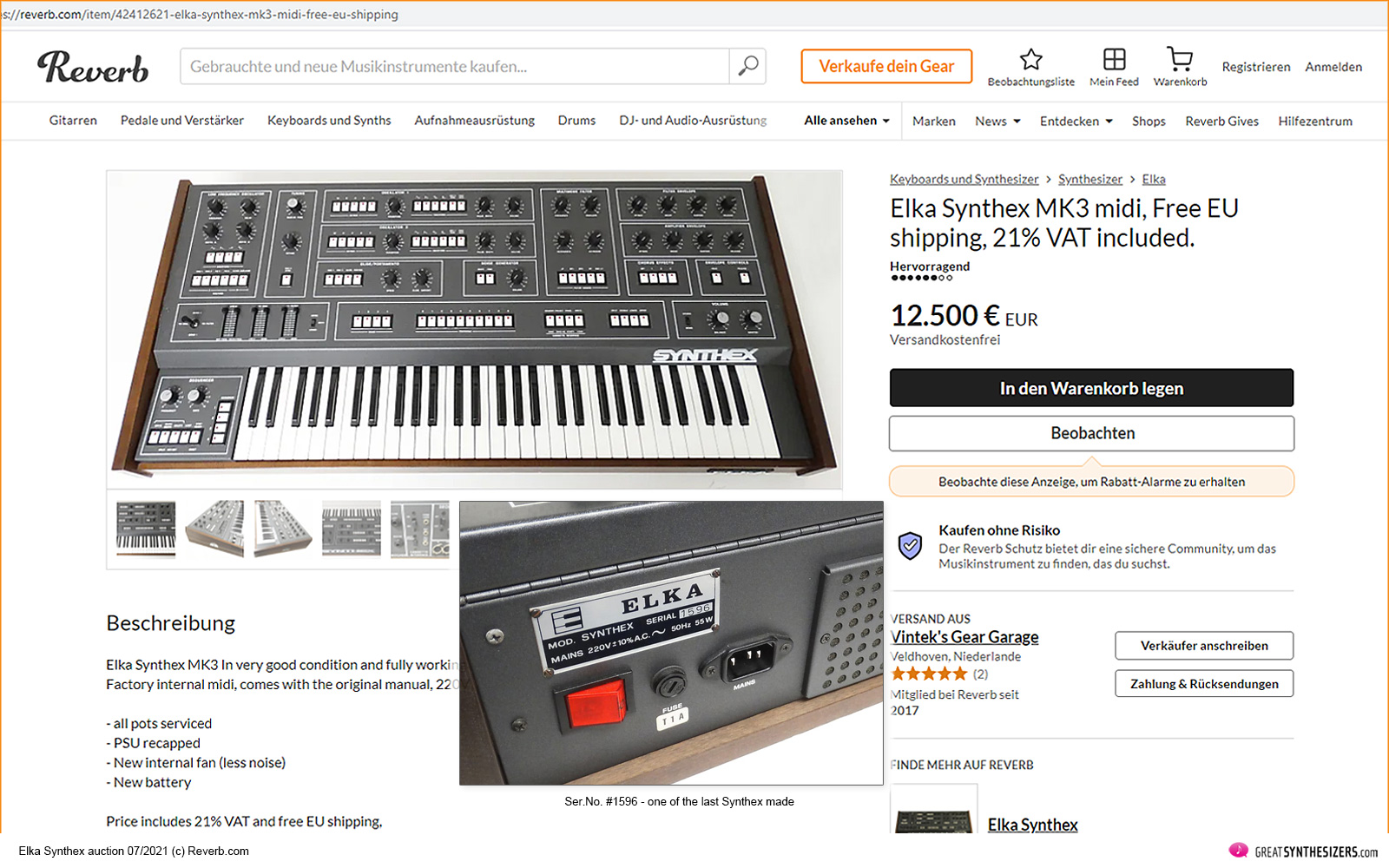

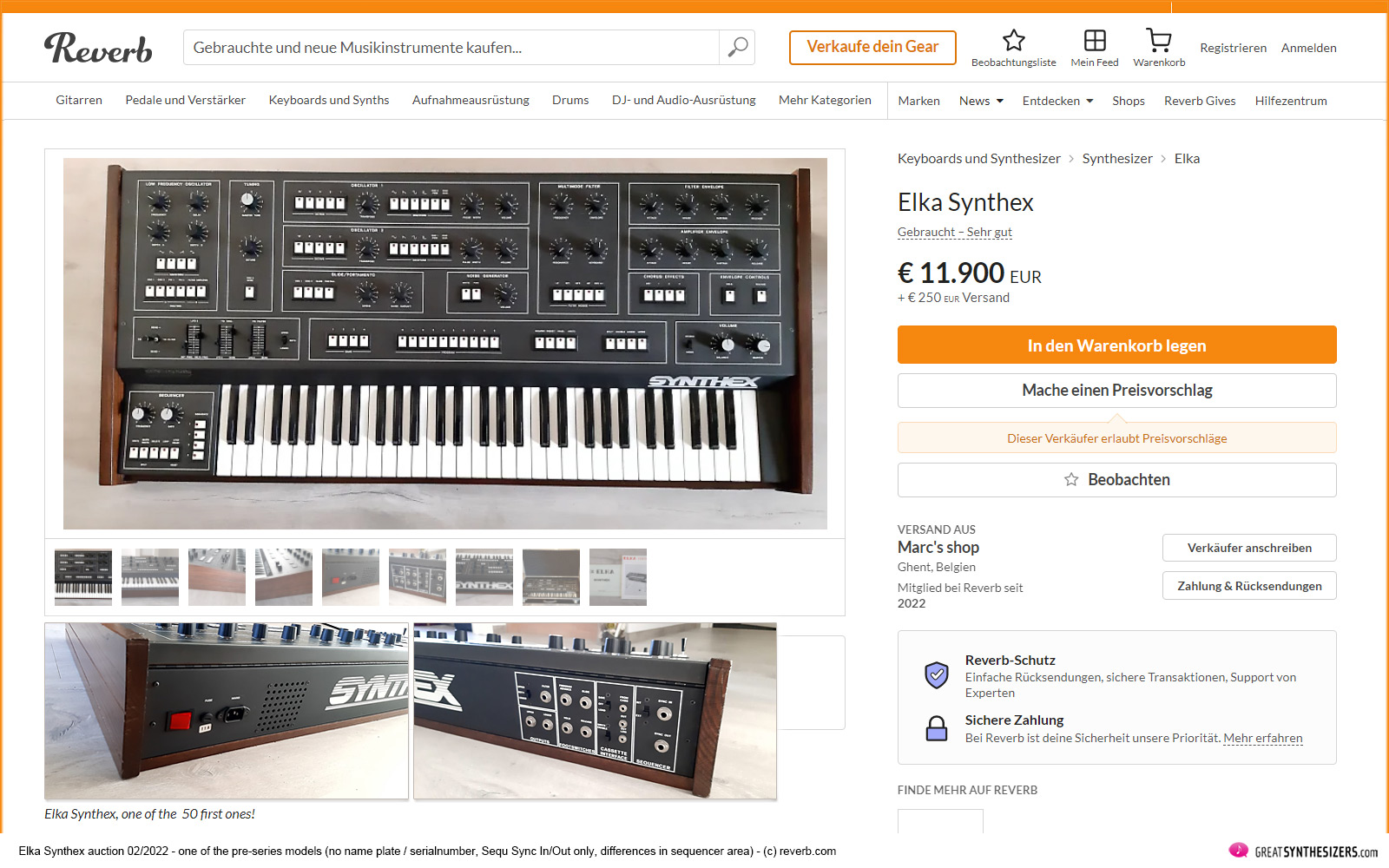
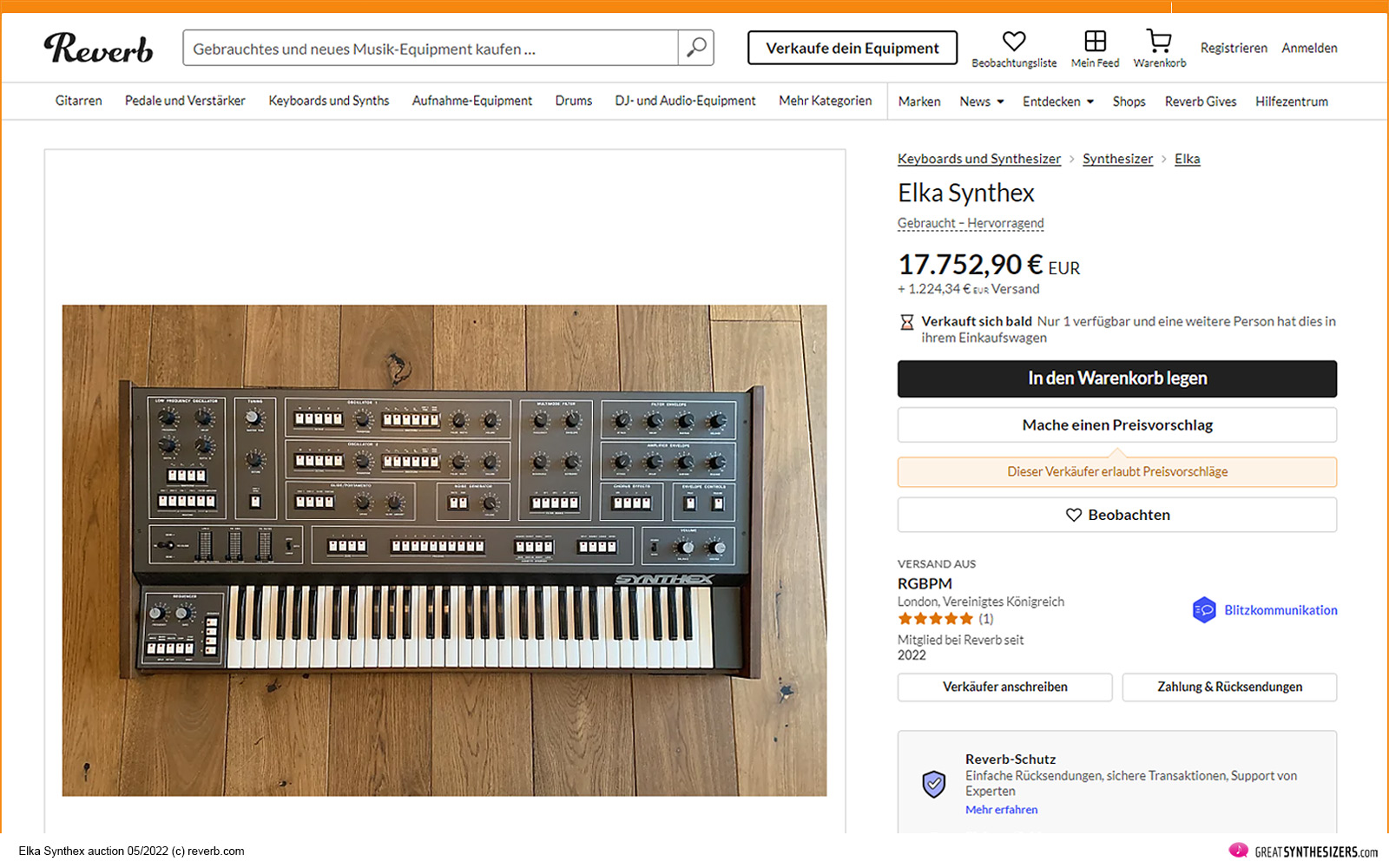

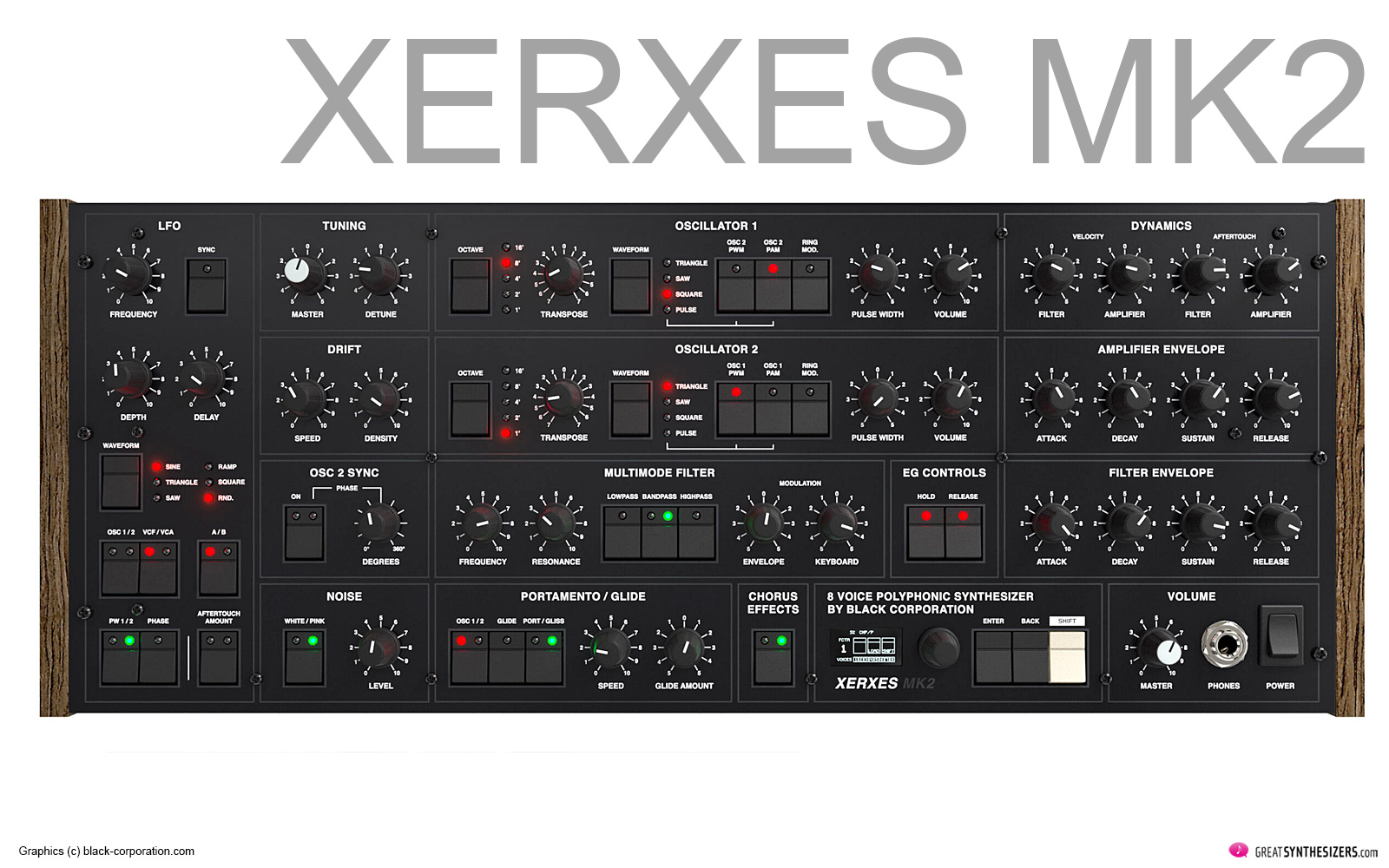
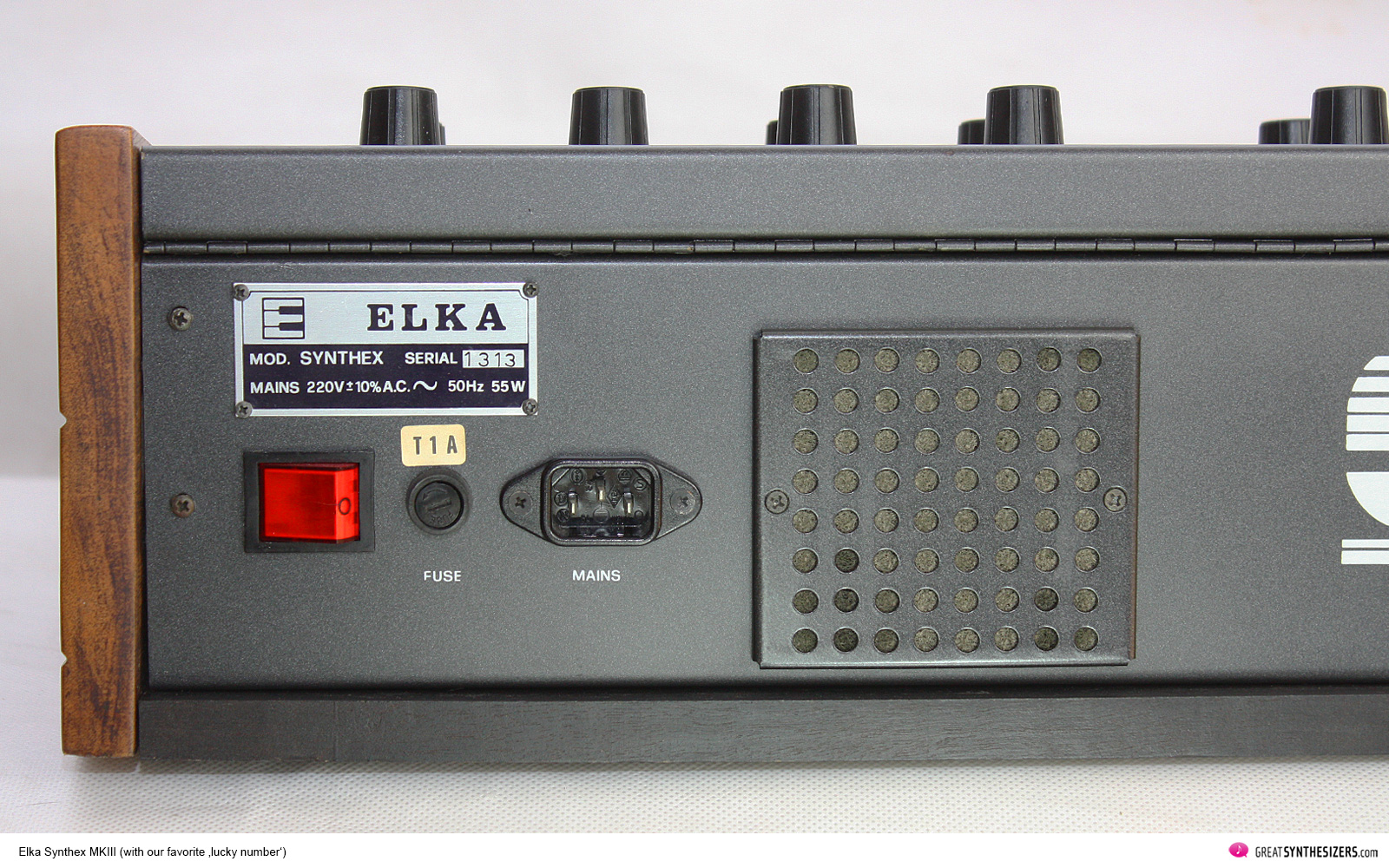
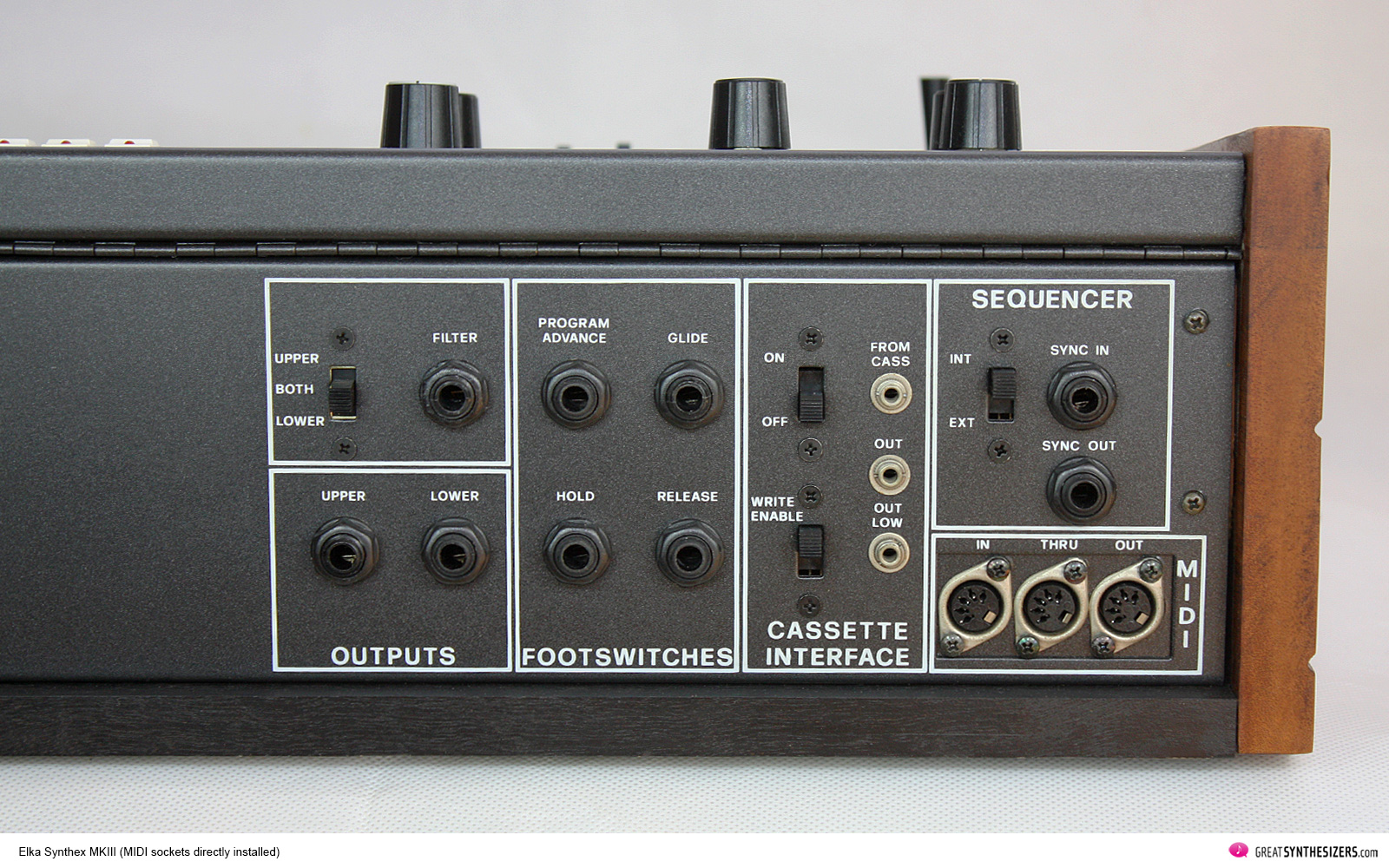
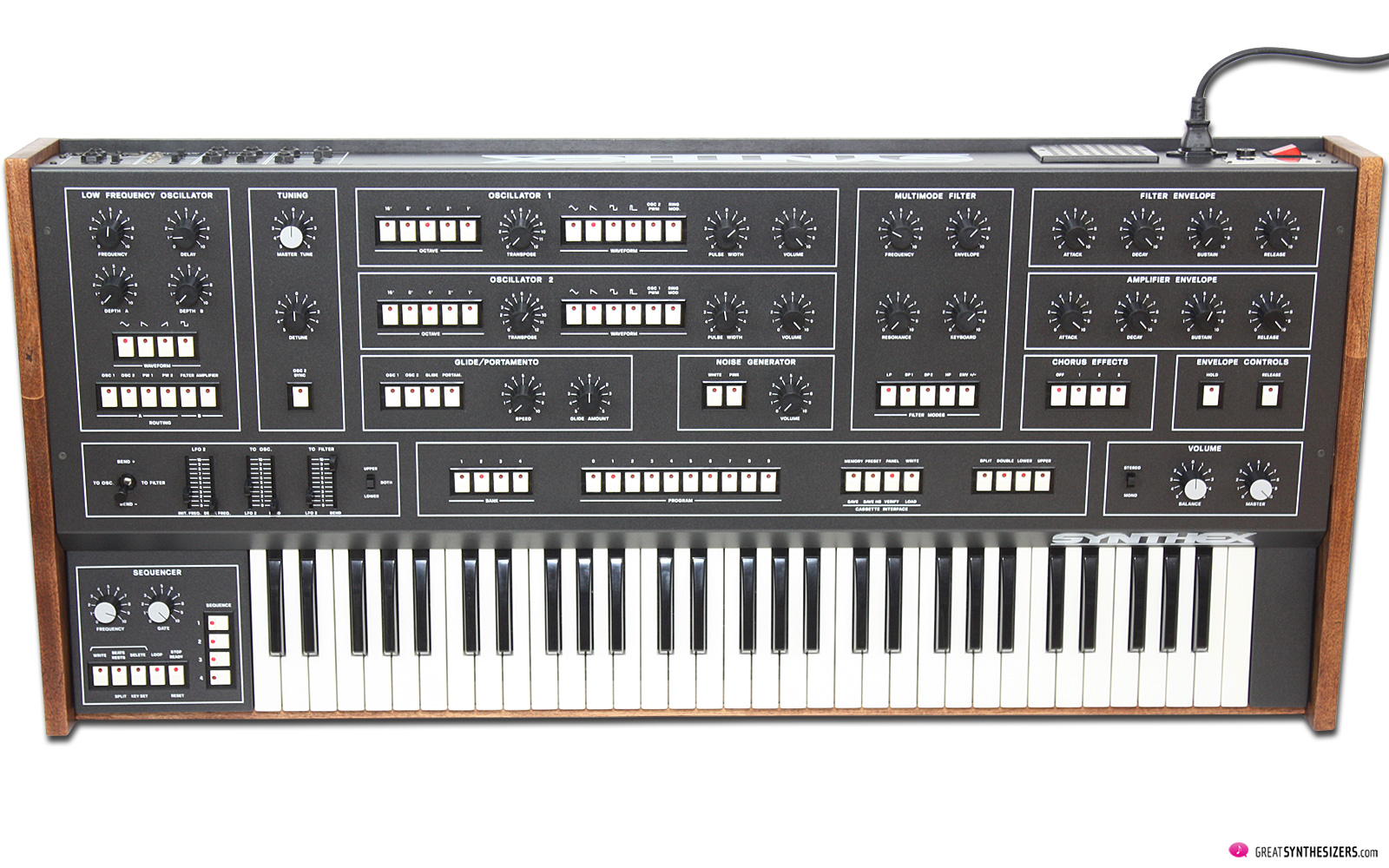
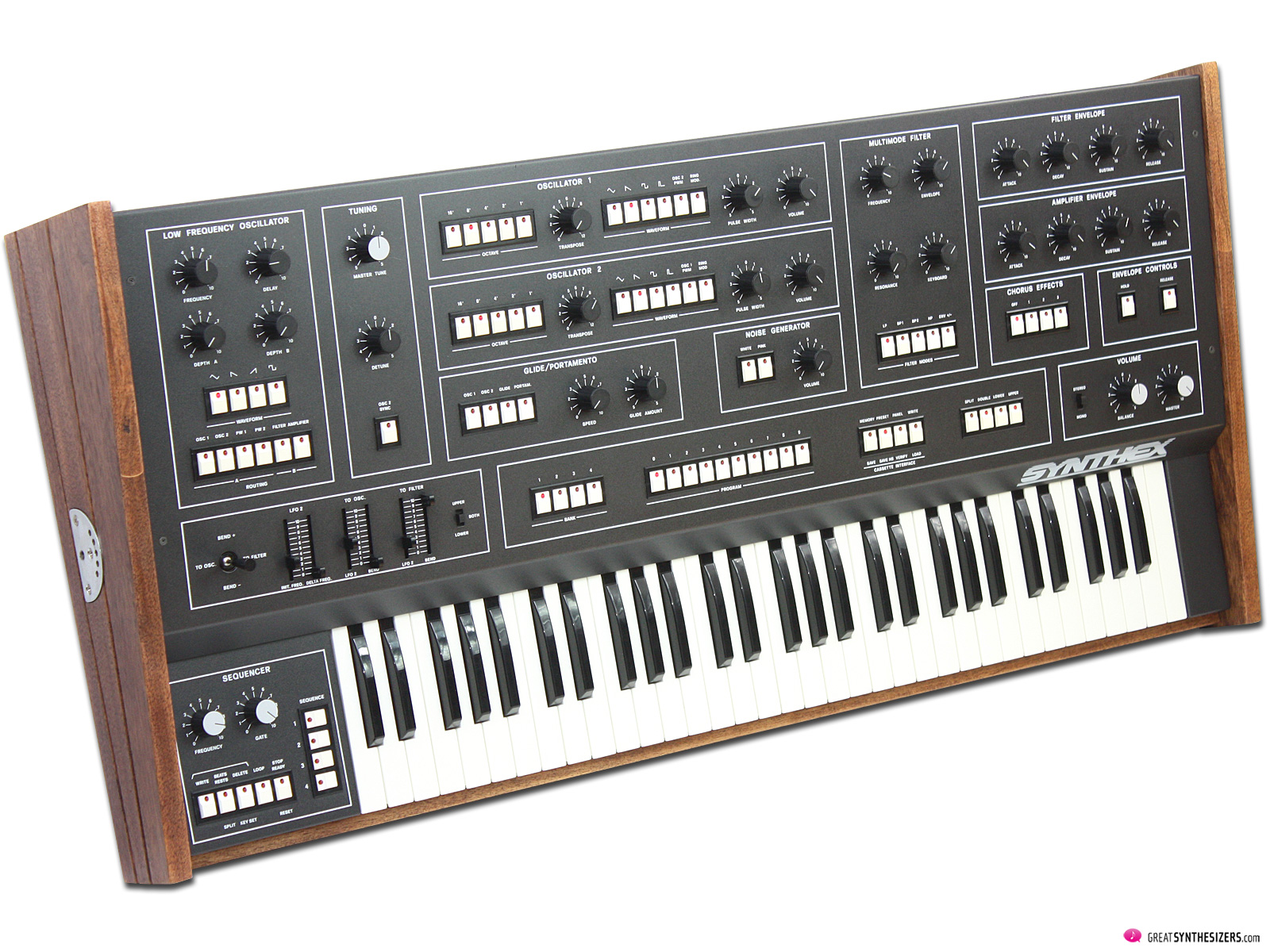
… hi Jeff – you’re right, the clone info was missing. Unfortunately we don’t have Xerxes to hand (honestly, we don’t trust “modern synth clones” (o:), but the particular mention of Xerxes should not be left out in any Synthex review. We just added some info about that Black Corporation synth. Thanks for your note … Regards – Theo
Was the Synthex the first synth keyboard featuring a fan?
I’ve never heard of that in other synths.
… there were earlier synths. The Memorymoog (1980), for example …
Thanks Theo, we learn something every day :)
Thank you Theo for this incredible test and source of information. I am now the happy owner of the n°1581, it brings me a pleasure that you describe perfectly in your lines. What an instrument !!!!
Hi Laurent … #1581 – one of the very last Synthex – congratulation! I added the number to our list of Synthex serial numbers. Thanks for the note, Laurent … Cheers – Theo
Hi, could be possible to post in your site a backup of the original 40 memories (was avaliable on cassette) for the synthex?. Several versions I have downloaded on other sites are broken / not complete. My synthex had no ram sounds when bought, would be great to have them restored. Thanks in advance.
… we just added the original Synthex factory presets (wav file) for download. Regards – Theo
Thanks Theo, I have seen your post almost a year later, sorry :-)
… meglio tardi che mai (o: